- 홈 > 장애인배구 > 등급분류
WPV 등급분류
World ParaVolley Classification Rules January 2018
Organization Organization ..................................................................................................... 2 Part One: General Provisions ............................................................................... 5 1 Scope and Application .................................................................................. 5 2 Roles and Responsibilities ............................................................................. 6 Part Two: Classification Personnel ........................................................................ 8 3 Classification Personnel ................................................................................ 8 4 Classifier Competencies, Training and Certification ........................................... 9 5 Classifier Code of Conduct .......................................................................... 10 Part Three: Athlete Evaluation ........................................................................... 11 6 General Provisions ..................................................................................... 11 7 Eligible Impairment ................................................................................... 11 8 Minimum Impairment Criteria ..................................................................... 14 9 Sport Class ............................................................................................... 14 10 Classification Not Completed..................................................................... 15 Part Four: Athlete Evaluation and the Classification Panel ...................................... 16 11 The Classification Panel ............................................................................ 16 12 Classification Panel Responsibilities............................................................ 16 13 Evaluation Sessions ................................................................................. 17 14 Observation in Competition ...................................................................... 18 15 Sport Class Status ................................................................................... 19 16 Notification ......................................................................................21 Part Five: Sport Class Not Eligible ...................................................................... 22 17 Sport Class Not Eligible ............................................................................ 22 Part Six: Protests............................................................................................ 24 18 Scope of a Protest ................................................................................... 24 19 Parties Permitted to Make a Protest............................................................ 24 20 National Protests..................................................................................... 24 21 National Protest Procedure ....................................................................... 24 22 World ParaVolley Protests........................................................................ 25 23 World ParaVolley Protest Procedure ........................................................... 26 24 Protest Panel .......................................................................................... 26 25 Provisions Where No Protest Panel is Available............................................. 27 26 Special Provisions................................................................................... 27 27 Ad Hoc Provisions Relating to Protests ........................................................ 28 Part Seven: Misconduct during Evaluation Session............................................... 29 28 Failure to Attend Evaluation Session .......................................................... 29 29 Suspension of Evaluation Session .............................................................. 29 Part Eight: Medical Review ................................................................................ 31 30 Medical Review ....................................................................................... 31 Part Nine: Intentional Misrepresentation ............................................................. 32 31 Intentional Misrepresentation ................................................................... 32 Part Ten: Use of Athlete Information .................................................................. 34 32 Classification Data................................................................................... 34 33 Consent and Processing ........................................................................... 34 34 Classification Research............................................................................ 34 35 Notification to Athletes ......................................................................34 36 Classification Data Security...................................................................... 35 37 Disclosures of Classification Data............................................................... 35 38 Retaining Classification Data ..................................................................... 35 39 Access Rights to Classification Data ........................................................... 35 40 Classification Master Lists ......................................................................... 36 Part Eleven: Appeals ........................................................................................ 37 41 Appeal ................................................................................................... 37 42 Parties Permitted to Make an Appeal .......................................................... 37 43 Appeals ................................................................................................. 37 44 Ad Hoc Provisions Relating to Appeals ........................................................ 37 Part Twelve: Glossary ...................................................................................... 38 Appendix One ................................................................................................. 44 1 Eligible Impairment Types .......................................................................... 44 Appendix Two ................................................................................................. 46 1 Non-Eligible Impairment Types for all Athletes ............................................... 46 2 Health Conditions that are not Underlying Health Conditions for all Athletes ....... 46 Appendix Three ............................................................................................... 47 1 Minimum Impairment Criteria ......................................................................... 47 2 Assessment Methodology............................................................................... 54 3 Assessment Criteria for Allocation of a Sport Class............................................ 71 Appendix Four................................................................................................ 75 1 Observation in Competition Assessment .......................................................... 75 Part One: General Provisions 1 Scope and Application Adoption 1.1 These Classification Rules and Regulations are referred to throughout this document as the ‘Classification Rules’. They have been prepared by World ParaVolley to implement the requirements of the 2015 IPC Athlete Classification Code and International Standards. 1.2 The Classification Rules have been adopted by World ParaVolley on January 1, 2018. 1.3 These Classification Rules refer to a number of Appendices. These Appendices form an integral part of the Classification Rules. 1.4 These Classification Rules form part of the World ParaVolley Rules and Regulations. 1.5 The Classification Rules are supplemented by a number of Classification forms that have been prepared to assist Athlete Evaluation. These forms are available from World ParaVolley, and can be amended by World ParaVolley from time to time. Classification 1.6 Classification is undertaken to: a) define who is eligible to compete in ParaVolley and consequently who has the opportunity to reach the goal of becoming a Paralympic Athlete; and b) group Athletes into Sport Classes which aim to ensure that the impact of Impairment is minimized and sporting excellence determines which team is ultimately victorious. Application 1.7 These Classification Rules apply to all Athletes and Athlete Support Personnel who are registered with World ParaVolley, and/or participate in any Events or Competitions organized, authorized or recognized by World ParaVolley. 1.8 These Classification Rules must be read and applied in conjunction with all other applicable rules of World ParaVolley, including but not limited to the sport technical rules of World ParaVolley. In the event of any conflict between these Classification Rules and any other rules, the Classification Rules shall take precedence. International Classification 1.9 World ParaVolley will only permit an Athlete to compete in an International Competition if that Athlete has been allocated a Sport Class (other than Sport Class Not Eligible) and designated with a Sport Class Status in accordance with these Classification Rules. 1.10 World ParaVolley will provide opportunities for Athletes to be allocated a Sport Class and designated with a Sport Class Status in accordance with these Classification Rules at Recognized Competitions (or other such locations as defined by World ParaVolley). World ParaVolley will advise Athletes, National Bodies and National Paralympic Committees in advance as to such Recognized Competitions(or other such locations). Interpretation and Relationship to Code 1.11 References to an ‘Article’ mean an Article of these Classification Rules, references to an ‘Appendix’ mean an Appendix to these Classification Rules, and Capitalized terms used in these Classification Rules have the meaning given to them in the Glossary to these Classification Rules. 1.12 References to a ‘sport’ in these Classification Rules refer to both the sport and disciplines within asport (for example “ParaVolley” and “Sitting Volleyball”). 1.13 The Appendices to these Classification Rules are part of these Classification Rules both of which may be amended, supplemented and/or replaced by World ParaVolley from time to time. 1.14 Headings used in these Classification Rules are used for convenience only and have no meaning that isseparate from the Article or Articles to which they refer. 1.15 These Classification Rules are to be applied and interpreted as an independent text but in a manner that is consistent with the 2015 IPC Athlete Classification Code and the accompanying International Standards. 2 Roles and Responsibilities 2.1 It is the personal responsibility of Athletes, Athlete Support Personnel, and Classification Personnel o familiarize themselves with all the requirements of these Classification Rules. Athlete Responsibilities 2.2 The roles and responsibilities of Athletes include to: a) be knowledgeable of and comply with all applicable policies, rules and processes established by these Classification Rules; b) participate in Athlete Evaluation in good faith; c) ensure when appropriate that adequate information related to Health Conditions and Eligible Impairments is provided and/or made available to World ParaVolley; d) cooperate with any investigations concerning violations of these Classification Rules; and e) actively participate in the process of education and awareness, and Classification research, through exchanging personal experiences and expertise. Athlete Support Personnel Responsibilities 2.3 The roles and responsibilities of Athlete Support Personnel include to: a) be knowledgeable of and comply with all applicable policies, rules and processes established by these Classification Rules; b) use their influence on Athlete values and behaviors to foster a positive and collaborative Classification attitude and communication; c) assist in the development, management and implementation of Classification Systems; and d) cooperate with any investigations concerning violations of these Classification Rules. Classification Personnel Responsibilities 2.4 The roles and responsibilities of Classification Personnel include to: a) have a complete working knowledge of all applicable policies, rules and processes established by these Classification Rules; b) use their influence to foster a positive and collaborative Classification attitude and communication; c) assist in the development, management and implementation of Classification Systems, including participation in education and research; and d) cooperate with any investigations concerning violations of these Classification Rules. Part Two: Classification Personnel 3 Classification Personnel 3.1 Classification Personnel are fundamental to the effective implementation of these Classification Rules. World ParaVolley will appoint a number of Classification Personnel, each of whom will have a key role in the organization, implementation and administration of Classification for World ParaVolley. Head of Classification 3.2 World ParaVolley must appoint a Head of Classification. The Head of Classification is a person responsible for the direction, administration, co-ordination and implementation of Classification matters for World ParaVolley. 3.3 If a Head of Classification cannot be appointed, World ParaVolley may appoint another person, or group of persons collectively (provided such person or group of persons agrees to comply with the Classifier Code of Conduct), to act as the Head of Classification. 3.4 The Head of Classification is required to be a certified Classifier. 3.5 The Head of Classification may delegate specific responsibilities and/or the transfer specific tasks to designated Classifiers, or other persons authorized by World ParaVolley. 3.6 Nothing in these Classification Rules prevents the Head of Classification from also being appointed as a Classifier and/or Chief Classifier. Classifiers 3.7 A Classifier is a person authorized as an official and certified by the World ParaVolley to conduct some or all components of Athlete Evaluation as a member of a Classification Panel. 3.8 Classifiers are responsible to be present and available to perform classification duties during the competition within the dates outlined by World ParaVolley. Chief Classifiers 3.9 A Chief Classifier is a Classifier appointed to direct, administer, co-ordinate and implement Classification matters for a specific Competition or at such other location as defined by World ParaVolley. In particular, a Chief Classifier is required by World ParaVolley to do the following. 3.9.1 identify those Athletes who will be required to attend an Athlete Evaluation Session; 3.9.2 supervise Classifiers to ensure that the these Classification Rules are properly applied during Classification; 3.9.3 manage Protests in consultation with World ParaVolley; and 3.9.4 liaise with the relevant Competition organizers to ensure that all travel, accommodation and other logistics are arranged in order that Classifiers may carry out their duties at the Competition. 3.10 A Chief Classifier may delegate specific responsibilities and/or transfer specific tasks to other appropriately qualified Classifiers, or other appropriately qualified World ParaVolley officers or representatives, and/or appropriately qualified persons in the local organizing committee of a Competition. Trainee Classifiers 3.11 A Trainee Classifier is a person who is in the process of formal training by World ParaVolley. 3.12 World ParaVolley may appoint Trainee Classifiers to participate in some or all components of Athlete Evaluation under the supervision of a Classification Panel, to develop Classifier Competencies. 4 Classifier Competencies, Training and Certification 4.1 A Classifier will be authorized to act as a Classifier if that Classifier has been certified by World ParaVolley as having the relevant Classifier Competencies. 4.2 World ParaVolley must provide training and education to Classifiers to ensure Classifiers obtain and/or maintain Classifier Competencies. 4.3 World ParaVolley must specify and publish Classifier Competencies in a manner that is transparent and accessible. The Classifier Competencies must include that a Classifier has: 4.3.1 a thorough understanding of these Classification Rules; 4.3.2 an understanding of Sitting Volleyball and other ParaVolley sport disciplines including an understanding of the technical rules of those sports; 4.3.3 an understanding of the Code and the International Standards; and 4.3.4 a professional qualification(s), level of experience, skills and/or competencies in order to act as a Classifier for World ParaVolley. These include that Classifiers must be a certified health professional in a field relevant to the Eligible Impairment category that World ParaVolley at its sole discretion deems acceptable, such as a physician or physiotherapist. 4.4 World ParaVolley must establish a process of Classifier Certification by which Classifier Competencies are assessed. This process must include: 4.4.1 a process for the certification of Trainee Classifiers; 4.4.2 quality assessment for the period of certification; 4.4.3 a process for handling substandard performance, including options for remediation and/or withdrawal of certification; and 4.4.4 a process for Re-certification of Classifiers. 4.5 World ParaVolley must specify Entry-Level Criteria applicable to persons who wish to become Trainee Classifiers. World ParaVolley will provide Entry-Level Education to Trainee Classifiers. 4.6 World ParaVolley must provide Continuing Education to Classifiers for the purposes of Certification and Re-certification. 4.7 World ParaVolley may provide that a Classifier is subject to certain limitations, including (but not limited to): 4.7.1 a limitation on the level of Competition or Event that a Classifier is authorized to act as a Classifier; 4.7.2 the maximum time that a Classifier Certification is valid; 4.7.3 that Classifier Certification is subject to review within a specific time frame by reference to the Classifier Competencies; 4.7.4 that a Classifier may lose Classifier Certification if World ParaVolley is not satisfied that the Classifier possesses the required Classifier Competencies; and/or 4.7.5 that a Classifier may regain Classifier Certification if World ParaVolley is satisfied that the Classifier possesses the required Classifier Competencies. 5 Classifier Code of Conduct 5.1 The integrity of Classification in World ParaVolley depends on the conduct of Classification Personnel. World ParaVolley has therefore adopted a set of professional conduct standards referred to as the ‘Classifier Code of Conduct’. 5.2 All Classification Personnel must comply with the Classifier Code of Conduct. 5.3 Any person who believes that any Classification Personnel may have acted in a manner that contravenes the Classifier Code of Conduct must report this to World ParaVolley. 5.4 If World ParaVolley receives such a report it will investigate the report and, if appropriate, take disciplinary measures. 5.5 World ParaVolley has discretion to determine whether or not a Classifier has an actual, perceived and/or potential conflict of interest. Part Three: Athlete Evaluation 6 General Provisions 6.1 World ParaVolley has specified in these Classification Rules the process, assessment criteria and methodology whereby Athletes will be allocated a Sport Class and designated a Sport Class Status. This process is referred to as Athlete Evaluation. 6.2 Athlete Evaluation encompasses a number of steps and these Classification Rules therefore include provisions regarding: 6.2.1 an assessment of whether or not an Athlete has an Eligible Impairment for the sport; 6.2.2 an assessment of whether an Athlete complies with Minimum Impairment Criteria for the sport; and 6.2.3 the allocation of a Sport Class (and designation of a Sport Class Status) depending on the extent to which an Athlete is able to execute the specific tasks and activities fundamental to the sport 7 Eligible Impairment 7.1 Any Athlete wishing to compete in a sport discipline governed by World ParaVolley must have an Eligible Impairment and that Eligible Impairment must be Permanent. 7.2 Appendix One of these Classification Rules specifies the Eligible Impairment(s) an Athlete must have in order to compete in a sport discipline governed by World ParaVolley. 7.3 Any Impairment that is not listed as Eligible Impairment in Appendix One is referred to as a Non-Eligible Impairment. Appendix Two includes examples of Non-Eligible Impairments. Assessment of Eligible Impairment 7.4 World ParaVolley must determine if an Athlete has Eligible Impairment. 7.4.1 In order to be satisfied that an Athlete has an Eligible Impairment, World ParaVolley may require any Athlete to demonstrate that he or she has an Underlying Health Condition. Appendix Two lists examples of Health Conditions that are not Underlying Health Conditions. 7.4.2 The means by which World ParaVolley determines that an individual Athlete has an Eligible Impairment is at the sole discretion of World ParaVolley. World ParaVolley may consider that an Athlete’s Eligible Impairment is sufficiently obvious and therefore not require evidence that demonstrates the Athlete’s Eligible Impairment. 7.4.3 If in the course of determining if an Athlete has an Eligible Impairment World ParaVolley becomes aware that the Athlete has a Health Condition, and believes that the impact of that Health Condition may be that it is unsafe for that Athlete to compete or there is a risk to the health of the Athlete (or other Athletes) if that Athlete competes, it may designate the Athlete as Classification Not Completed (CNC) in accordance with Article 10 of these Classification Rules. In such instances World ParaVolley will explain the basis of its designation to the relevant National Body and/or National Paralympic Committee. 7.5 All Athletes are required to submit a Medical Diagnostics Form and must (if requested to do so) supply additional Diagnostic Information to World ParaVolley as follows: 7.5.1 The relevant National Body and/or National Paralympic Committee must submit a Medical Diagnostics Form to World ParaVolley (classification@worldparavolley.org), upon completing the registration of a new Athlete 7.5.2 The Medical Diagnostics Form must be completed in English and dated and signed by a certified health care professional with expertise in the relevant impairment type and who has not been associated with the team in any capacity within the last five years. 7.5.3 The Medical Diagnostic Form must be submitted to the World ParaVolley Head of Classification. For some athletes that will be enough. Some athletes will be required by World ParaVolley to provide supportive Diagnostic Information. 7.5.4 World ParaVolley will establish an Eligibility Assessment Committee that will support the work of the Head of Classification in review of Medical Diagnostic Forms and supporting Diagnostic Information. 7.6 World ParaVolley may require the relevant National Body and/or National Paralympic Committee to re-submit an Athlete’s Medical Diagnostics Form (with necessary supporting Diagnostic Information) if World ParaVolley at its sole discretion considers the Medical Diagnostic Form and/or the Diagnostic Information to be incomplete or inconsistent. 7.7 The process by which the Eligibility Assessment Committee considers the Medical Diagnostic Form & Diagnostic Information is as follows: 7.7.1 The Head of Classification will notify the relevant National Body or National Paralympic Committee that Diagnostic Information must be provided on behalf of the Athlete. The Head of Classification will explain what Diagnostic Information is required, and the purposes for which it is required. 7.7.2 The Head of Classification will set timelines for the production of Diagnostic Information. 7.7.3 The Eligibility Assessment Committee will be comprised of, at least, the Head of Classification and two other experts with appropriate medical qualifications. These experts may or may not be World ParaVolley International Classifiers, and will have expertise relevant to the impairment. 7.7.4 All members of the Eligibility Assessment Committee must sign confidentiality undertakings. 7.7.5 Wherever possible all references to the individual Athlete should be withheld from the Eligibility Assessment Committee. Each member of the Eligibility Assessment Committee will review the Diagnostic Information and decide whether such information establishes the existence of an Eligible Impairment. 7.7.6 If the Eligibility Assessment Committee concludes that the Athlete has an Eligible Impairment the Athlete will be permitted to complete Athlete Evaluation with a Classification Panel. 7.7.7 If the Eligibility Assessment Committee is not satisfied that the Athlete has an Eligible Impairment the Head of Classification will provide a decision to this effect in writing to the relevant National Body or National Paralympic Committee. 7.7.8 The National Body or National Paralympic Committee will be given an opportunity to comment on the decision within 10 business days of receipt of the decision and may provide further Diagnostic Information to the Eligibility Assessment Committee for review. 7.7.9 If the decision is subsequently revised, the Head of Classification will inform the National Body or National Paralympic Committee by issuing a final decision letter to that body no later than 10 days after receipt. 7.8 If the decision is not changed, the Head of Classification will issue a final decision letter within 10 business days to the National Body or National Paralympic Committee. 7.8.1 The Eligibility Assessment Committee may make its decisions by a majority. As the Chair of the Committee, if the Head of Classification does not agree that the Diagnostic Information supports the decision regarding the Eligible Impairment, he or she may request that the Eligibility Assessment Committee reconsiders its decision and seeks additional information and expertise. 7.9 In exceptional circumstances and at the sole discretion of the Head of Classification, one or more of the functions above may be delegated to the Chief Classifier for a specific event 8 Minimum Impairment Criteria 8.1 An Athlete who wishes to compete in a sport must have an Eligible Impairment that complies with the relevant Minimum Impairment Criteria for that sport. 8.2 World ParaVolley has set Minimum Impairment Criteria to ensure that an Athlete’s Eligible Impairment affects the extent to which an Athlete is able to execute the specific tasks and activities fundamental to the sport. 8.3 Appendix Three of these Classification Rules specifies the Minimum Impairment Criteria applicable to each World ParaVolley sport and the process by which an Athlete’s compliance with Minimum Impairment Criteria is to be assessed by a Classification Panel as part of an Athlete Evaluation Session. 8.4 Any Athlete who does not comply with the Minimum Impairment Criteria for a sport must be allocated Sport Class Not Eligible (NE) for that sport. 8.5 A Classification Panel must assess whether or not an Athlete complies with Minimum Impairment Criteria. This will take place as part of an Athlete Evaluation Session. Prior to participating in an Athlete Evaluation Session, an Athlete must first satisfy WorldParaVolley that he or she has an Eligible Impairment. 8.6 In relation to the use of Adaptive Equipment, World ParaVolley has set Minimum Impairment Criteria as follows: 8.6.1 for Eligible Impairments, Minimum Impairment Criteria must not consider the extent to which the use of Adaptive Equipment might affect how the Athlete is able to execute the specific tasks and activities fundamental tothe sport; 9 Sport Class 9.1 A Sport Class is a category defined by World ParaVolley in these Classification Rules, in which Athletes are grouped by reference to the impact of an Eligible Impairment on their ability to execute the specific tasks and activities fundamental to a sport. 9.1.1 An Athlete who does not have an Eligible Impairment or does not comply with the Minimum Impairment Criteria for a sport must be allocated Sport Class Not Eligible (NE) for that sport in accordance with the provisions of Article 17 of these Classification Rules. 9.1.2 An Athlete who complies with the Minimum Impairment Criteria for a sport must be allocated a Sport Class (subject to the provisions in these Classification Rules concerning Failure to Attend Athlete Evaluation and Suspension of Athlete Evaluation). 9.1.3 Except for the allocation of Sport Class Not Eligible (NE) by World ParaVolley (in accordance with Article 18.1), the allocation of a Sport Class must be based solely on an evaluation by a Classification Panel of the extent to which the Athlete’s Eligible Impairment affects the specific tasks and activities fundamental to sport. This evaluation must take place in a controlled non-competitive environment, which allows for the repeated observation of key tasks and activities. 9.2 Appendix Three of these Classification Rules specifies the assessment methodology and assessment criteria for the allocation of a Sport Class and the designation of Sport Class Status. 9.3 In determining Sport Class, the extent to which the use of an orthosis or upper limb prosthesis might affect the execution of specific tasks and activities fundamental to the sport must not be considered. Wearing any kind of orthosis or upper limb prosthesis on court cannot change the athlete’s class. The dimensions of any prosthesis or orthosis worn on court must be equivalent to the dimensions of the unaffected side or within the anthropometric norms. 10 Classification Not Completed 10.1 If at any stage of Athlete Evaluation World ParaVolley or a Classification Panel is unable to allocate a Sport Class to an Athlete, the Head of Classification or the relevant Chief Classifier may designate that Athlete as Classification Not Completed (CNC). 10.2 The designation Classification Not Completed (CNC) is not a Sport Class and is not subject to the provisions in these Classification Rules concerning Protests. The designation Classification Not Completed (CNC) will however be recorded for the purpose of the World ParaVolley Classification Master List. 10.3 An Athlete who is designated as Classification Not Completed (CNC) may not compete in the sport disciplines of World ParaVolley. Part Four: Athlete Evaluation and the Classification Panel 11 The Classification Panel 11.1 A Classification Panel is a group of Classifiers appointed by World ParaVolley to conduct some or all of the components of Athlete Evaluation including as part of an Evaluation Session. General Provisions 11.2 A Classification Panel must be comprised of at least of two certified Classifiers. In exceptional circumstances The Head of Classification or a Chief Classifier may provide that a Classification Panel comprise only one Classifier. 11.3 A Trainee Classifier may be part of a Classification Panel in addition to the required number of certified Classifiers, and may participate in Athlete Evaluation. 12 Classification Panel Responsibilities 12.1 A Classification Panel is responsible for conducting an Evaluation Session. As part of the Athlete Evaluation Session the Classification Panel must: 12.1.1 assess whether an Athlete complies with Minimum Impairment Criteria for the sport and discipline; 12.1.2 assess the extent to which an Athlete is able to execute the specific tasks and activities fundamental to the sport; and 12.1.3 conduct (if required) Observation in Competition. 12.2 Following the Athlete Evaluation Session the Classification Panel must allocate a Sport Class and designate a Sport Class Status, or designate Classification Not Completed (CNC). 12.3 Prior to the Athlete Evaluation Session, the assessment as to whether an Athlete has an Eligible Impairment must be undertaken by World ParaVolley, unless World ParaVolley requests this to be undertaken by a Classification Panel. 12.4 The Athlete Evaluation Session must take place in a controlled non-competitive environment that allows for the repeated observation of key tasks and activities. 12.4.1 Although other factors such as low fitness level, poor technical proficiency and aging may also affect the fundamental tasks and activities of the sport, the allocation of Sport Class must not be affected by these factors. 12.5 An Athlete who has a Non-Eligible Impairment and an Eligible Impairment may be evaluated by a Classification Panel on the basis of the Eligible Impairment, provided the Non-Eligible Impairment does not affect the Classification Panel’s ability to allocate a Sport Class. 12.6 The Sport Class allocated to the Athlete will be in accordance with the processes specified in Appendix Three. 13 Athlete Evaluation Sessions 13.1 This Article applies to all Athlete Evaluation Sessions. 13.2 The Athlete’s National Body or National Paralympic Committee is responsible for ensuring that Athletes comply with their duties in relation to the provisions in this Article. 13.3 In respect of Athletes: 13.3.1 Athletes have the right to be accompanied by a member of the Athlete’s National Body or National Paralympic Committee when attending an Athlete Evaluation Session. The Athlete must be accompanied if the Athlete is a minor or has Intellectual Impairment in addition to a physical impairment. 13.3.2 The person chosen by the Athlete to accompany the Athlete at an Evaluation Session should be familiar with the Athlete’s Impairment and sport history. 13.3.3 The Athlete and accompanying person must acknowledge the terms of the Athlete Evaluation Consent (Agreement) Form as specified by World ParaVolley. 13.3.4 The Athlete must verify his or her identity to the satisfaction of the Classification Panel, by providing a document such as a passport, or other nationally recognized photo ID card if a passport is not available. The chief classifier may, at his/her sole discretion, accept a formal photo ID of the athlete issued by the nation where the event takes place. 13.3.5 The Athlete must attend the Athlete Evaluation Session with any sports attire or equipment relevant to the sport for which the Athlete wishes to be allocated a Sport Class. 13.3.6 The Athlete must disclose the use of any medication and/or medical device/implant to the Classification Panel. 13.3.7 The Athlete must comply with all reasonable instructions given by a Classification Panel. 13.4 In respect of the Classification Panel: 13.4.1 The Classification Panel may request that an Athlete provide medical documentation relevant to the Athlete’s Eligible Impairment if the Classification Panel believes that this will be necessary in order for it to allocate a Sport Class. 13.4.2 The Classification Panel will conduct Athlete Evaluation Sessions in English unless otherwise stipulated by World ParaVolley. If the Athlete requires an interpreter, a member of the Athlete’s National Body or National Paralympic Committee will be responsible for arranging for an interpreter. The interpreter is permitted to attend the Athlete Evaluation Session in addition to the person referred to in Article 13.3.1 above. 13.4.3 The Classification Panel may at any stage seek medical, technical or scientific opinion(s), with the agreement of the Head of Classification and/or a Chief Classifier if the Classification Panel feels that such opinion(s) is necessary in order to allocate a Sport Class. 13.4.4 In addition to any opinion(s) sought in accordance with Article 13.4.3, a Classification Panel may only have regard to evidence supplied to it by the relevant Athlete, National Body, National Paralympic Committee and World ParaVolley (from any source) when allocating a Sport Class. 13.4.5 The Classification Panel may make, create or use video footage and/or other records to assist it when allocating a Sport Class. 14 Observation in Competition 14.1 A Classification Panel may require that an Athlete undertake Observation in Competition Assessment before it allocates a final Sport Class and designates a Sport Class Status to that Athlete. 14.2 The methods by which Observation in Competition Assessment may be undertaken, and the matters to be observed, are set out in Appendix Four. 14.3 If a Classification Panel requires an Athlete to complete Observation in Competition Assessment, the Athlete will be entered in the Competition with the Sport Class allocated by the Classification Panel after the conclusion of the initial components of the Athlete Evaluation Session. 14.4 An Athlete who is required to complete Observation in Competition Assessment will be designated with Tracking Code: Observation Assessment (OA). This replaces the Athlete’s Sport Class Status for the duration of Observation in Competition Assessment. 14.5 Observation in Competition Assessment must take place during First Appearance. In this regard: 14.5.1 First Appearance is the first time an Athlete competes during a Competition in a particular Sport Class. 14.5.2 An Athlete who competes in a World ParaVolley Sport must make First Appearance during the preliminary rounds of a Competition. First Appearance must not take place in the elimination rounds of a Competition. 14.6 If an Athlete is: a) subject to a Protest following Observation in Competition; and b) the second Athlete Evaluation Session is conducted at that same Competition; and c) pursuant to the second Athlete Evaluation Session the Athlete is required to undergo Observation in Competition, Observation in Competition must take place at the next opportunity within the Sport Class allocated to the Athlete by the Protest Panel with Tracking Code Observation Assessment (OA). 14.6.1 The Classification Panel must allocate a Sport Class and replace the Athlete’s Tracking Code Observation Assessment (OA) by designating a Sport Class Status upon completion of First Appearance (or completion of any Observation in Competition conducted as part of a Protest). If changes to an Athlete’s Sport Class or Sport Class Status are made following Observation in Competition, the changes are effective immediately. 14.7 The impact of an Athlete changing Sport Class after First Appearance on medals, records and results is detailed in the World ParaVolley Rules and Regulations. 15 Sport Class Status 15.1 If a Classification Panel allocates a Sport Class to an Athlete, it must also designate a Sport Class Status. Sport Class Status indicates whether or not an Athlete will be required to undertake Athlete Evaluation in the future; and if the Athlete’s Sport Class may be subject to Protest. 15.2 The Sport Class Status designated to an Athlete by a Classification Panel at the conclusion of an Athlete Evaluation Session will be one of the following: • Confirmed (C) • Review (R) • Review with a Fixed Review Date (FRD) Sport Class Status New 15.3 An Athlete is allocated Sport Class Status New (N) by World ParaVolley prior to attending the Athlete’s first Evaluation Session. An Athlete with Sport Class Status New (N) must attend an Athlete Evaluation Session prior to competing at any International Competition, unless World ParaVolley specifies otherwise. Sport Class Status Confirmed 15.4 An Athlete will be designated with Sport Class Status Confirmed (C) if the Classification Panel is satisfied that both the Athlete’s Eligible Impairment and the Athlete’s ability to execute the specific tasks and activities fundamental to the sport are and will remain stable. 15.4.1 An Athlete with Sport Class Status Confirmed (C) is not required to undergo any further Athlete Evaluation (save pursuant to the provisions in these Classification Rules concerning Protests (Article 19), Medical Review (Article 31) and changes to Sport Class criteria (Article 15.7). 15.4.2 A Classification Panel that consists of only one Classifier may not designate an Athlete with Sport Class Status Confirmed (C) but must designate the Athlete with Sport Class Status Review (R). Sport Class Status Review 15.5 An Athlete will be designated Sport Class Status Review (R) if the Classification Panel believes that further AthleteEvaluation Sessions will be required. 15.5.1 A Classification Panel may base its belief that further Athlete Evaluation Sessions will be required based on a number of factors, including but not limited to situations where the Athlete has only recently entered Competitions sanctioned or recognized by World ParaVolley; has a fluctuating and/or progressive Impairment/Impairments that is/are permanent but not stable; and/or has not yet reached full muscular, skeletal or sports maturity. 15.5.2 An Athlete with Sport Class Status Review (R) must complete Athlete Evaluation prior to competing at any subsequent International Competition, unless World ParaVolley specifies otherwise. Sport Class Status Review with Fixed Review Date 15.6 An Athlete may be designated Sport Class Status Review with a Fixed Review Date (FRD) if the Classification Panel believes that further Athlete Evaluation will be required but will not be necessary before a set date, being the Fixed Review Date. 15.6.1 An Athlete with Sport Class Status Review with a Fixed Review Date (FRD) will be required to attend an Athlete Evaluation Session at the first opportunity after the relevant Fixed Review Date. 15.6.2 An Athlete who has been allocated Sport Class Status Review with a Fixed Review Date (FRD) may not attend an Athlete Evaluation Session prior to the relevant Fixed Review Date save pursuant to a Medical Review Request and/or Protest. 15.6.3 A Classification Panel that consists of only one Classifier may not designate an Athlete with Sport Class Status Review with a Fixed Review Date (FRD) but must designate the Athlete with Sport Class Status Review (R). Changes to Sport Class Criteria 15.7 If World ParaVolley changes any Sport Class criteria and/ or assessment methods defined in the Appendices to these Rules, then: 15.7.1 World ParaVolley may re-assign any Athlete who holds Sport Class Status Confirmed (C) with Sport Class Status Review (R) and require that the Athlete attend an Athlete Evaluation Session at the earliest available opportunity; or 15.7.2 World ParaVolley may remove the Fixed Review Date for any Athlete and require that the Athlete attend an Athlete Evaluation Session at the earliest available opportunity; and 15.7.3 in both instances the relevant National Body or National Paralympic Committee shall be informed as soon as is practicable. 16 Notification 16.1 The outcome of Athlete Evaluation must be notified to the Athlete and/or National Body or National Paralympic Committee and published as soon as practically possible after completion of Athlete Evaluation. 16.2 World ParaVolley must publish the outcome of Athlete Evaluation at the Competition following Athlete Evaluation, and the outcomes must be made available post Competition via the Classification Master List at World ParaVolley website. Part Five: Sport Class Not Eligible 17 Sport Class Not Eligible General Provisions 17.1 If World ParaVolley, or the Eligibility Assessment Committee of World ParaVolley, determines that an Athlete: 17.1.1 has an Impairment that is not an Eligible Impairment; or 17.1.2 does not have an Underlying Health Condition, World ParaVolley must allocate that Athlete Sport Class Not Eligible (NE). 17.2 If a Classification Panel determines that an Athlete who has an Eligible Impairment does not comply with Minimum Impairment Criteria for a sport that Athlete must be allocated Sport Class Not Eligible (NE) for that sport. Absence of Eligible Impairment 17.3 If World ParaVolley, or the Eligibility Assessment Committee, determines that an Athlete does not have an Eligible Impairment, that Athlete: 17.3.1 will not be permitted to attend an AthleteEvaluation Session; and 17.3.2 will be allocated with Sport Class Not Eligible (NE) and designated with Sport Class Status Confirmed (C) by World ParaVolley. 17.4 If another International Sport Federation has allocated an Athlete with Sport Class Not Eligible (NE) because the Athlete does not have an Eligible Impairment World ParaVolley may likewise do so without the need for the process detailed in Article 7 of these Classification Rules. 17.5 An Athlete who is allocated Sport Class Not Eligible (NE) by World ParaVolley or a Classification Panel (if delegated by World ParaVolley) because that Athlete has 17.5.1 an Impairment that is not an Eligible Impairment; or 17.5.2 a Health Condition that is not an Underlying Health Condition; has no right to request such determination be reviewed by a second Classification Panel and will not be permitted to participate in any sport. Absence of Compliance with Minimum Impairment Criteria 17.6 A second Classification Panel must review by way of a second Evaluation Session any Athlete who is allocated Sport Class Not Eligible (NE) on the basis that a Classification Panel determines that the Athlete does not comply with Minimum Impairment Criteria. This must take place as soon as is practicable. 17.6.1 Pending the second Athlete Evaluation Session the Athlete will be allocated Sport Class Not Eligible (NE) and designated Sport Class Status Review (R). The Athlete will not be permitted to compete before such re-assessment. 17.6.2 If the second Classification Panel determines the Athlete does not comply with Minimum Impairment Criteria (or if the Athlete declines to participate in a second Evaluation Session at the time set by the Chief Classifier); Sport Class Not Eligible (NE) will be allocated and the Athlete designated with Sport Class Status Confirmed (C). 17.7 If an Athlete makes (or is subject to) a Protest on a previously allocated Sport Class other than Not Eligible (NE) and is allocated Sport Class Not Eligible (NE) by a Protest Panel, the Athlete must be provided with a further and final Evaluation Session which will review the decision to allocate Sport Class Not Eligible (NE) made by the Protest Panel. 17.8 If a Classification Panel allocates Sport Class Not Eligible (NE) on the basis that it has determined that an Athlete does not comply with Minimum Impairment Criteria for a World ParaVolley sport the Athlete may be eligible to compete in another sport, subject to Athlete Evaluation for that sport. 17.9 If an Athlete is allocated Sport Class Not Eligible (NE), this does not question the presence of a genuine Impairment. It is only a ruling on the eligibility of the Athlete to compete in the sport of World ParaVolley. Part Six: Protests 18 Scope of a Protest 18.1 A Protest may only be made in respect of an Athlete’s Sport Class. A Protest may not be made in respect of an Athlete’s Sport Class Status. 18.2 A Protest may not be made in respect of an Athlete who has been allocated Sport Class Not Eligible (NE). 19 Parties Permitted to Make a Protest A Protest may only be made by one of the following bodies: 19.1 a National Body (see Articles 20-21); or 19.2 World ParaVolley (see Articles 22-23). 20 National Protests 20.1 A National Body or a National Paralympic Committee may only make a Protest in respect of an Athlete under its jurisdiction at a Competition or venue set aside for Athlete Evaluation. 20.2 If the outcome of Athlete Evaluation is published prior to the first match of a Competition (pursuant to Article 16 of these Classification Rules) a National Protest must be submitted within one (1) hour of that outcome being published. If the outcome of Athlete Evaluation is published following Observation in Competition (after First Appearance), a National Protest must be submitted within sixty (60) minutes of that outcome being published or the team being notified. 20.3 If an Athlete is required by a Classification Panel to undergo Observation in Competition Assessment, a National Body or a National Paralympic Committee may make a Protest before or after First Appearance takes place. If a Protest is made before First Appearance takes place the Athlete must not be permitted to compete until the Protest has been resolved. 21 National Protest Procedure 21.1 To submit a National Protest, a National Body must show that the Protest is bona fide with supporting evidence and complete a Protest Form, that must be made available by World ParaVolley at the Competition and via World ParaVolley website, and must include the following: 21.1.1 the name of the Protested Athlete; 21.1.2 the details of the Protested Decision and/or a copy of the Protested Decision; 21.1.3 an explanation as to why the Protest has been made and the basis on which the National Body or National Paralympic Committee believes that the Protested Decision is flawed; 21.1.4 reference to the specific rule(s) alleged to have been breached; and 21.1.5 the Protest Fee (200 Euro) set by World ParaVolley. 21.2 The Protest Documents must be submitted to the Chief Classifier of the relevant Competition within the timeframes specified by World ParaVolley. Upon receipt of the Protest Documents the Chief Classifier must conduct a review of the Protest, in consultation with World ParaVolley, of which there are two possible outcomes: 21.2.1 the Chief Classifier may dismiss the Protest if, in the discretion of the Chief Classifier, the Protest does not comply with the Protest requirements in this Article 21; or 21.2.2 the Chief Classifier may accept the Protest if, in the discretion of the Chief Classifier, the Protest complies with the Protest requirements in this Article 21. 21.3 If the Protest is dismissed the Chief Classifier must notify all relevant parties and provide a written explanation to the National Body as soon as practicable. The Protest Fee will be forfeited. 21.4 If the Protest is accepted: 21.4.1 the Protested Athlete’s Sport Class must remain unchanged pending the outcome of the Protest but the Protested Athlete’s Sport Class Status must immediately be changed to Review (R) unless the Protested Athlete’s Sport Class Status is already Review (R); 21.4.2 the Chief Classifier must appoint a Protest Panel to conduct a new Athlete Evaluation Session as soon as possible, which must be either at the Competition the Protest was made or at the next Competition; and 21.4.3 World ParaVolley must notify all relevant parties of the time and date the new Athlete Evaluation Session is to be conducted by the Protest Panel. 22 World ParaVolley Protests 22.1 World ParaVolley may, in its discretion, make a Protest at any time in respect of an Athlete under its jurisdiction if: 22.1.1 it considers an Athlete may have been allocated an incorrect Sport Class; or 22.1.2 a National Body makes a documented request to World ParaVolley regarding an Athlete from another nation that is not under its jurisdiction. The assessment of the validity of the request is at the sole discretion of the World ParaVolley Chief Classifier. 23 World ParaVolley Protest Procedure 23.1 If World ParaVolley decides to make a Protest, the Head of Classification must advise the relevant National Body of the Protest at the earliest possible opportunity. 23.2 The Head of Classification must provide the relevant National Body with a written explanation as to why the Protest has been made and the basis on which the Head of Classification considers it is justified. 23.3 If World ParaVolley makes a Protest: 23.3.1 the Protested Athlete’s Sport Class must remain unchanged pending the outcome of the Protest; 23.3.2 the Protested Athlete’s Sport Class Status must immediately be changed to Review (R) unless the Protested Athlete’s Sport Class Status is already Review (R); and 23.3.3 a Protest Panel must be appointed to resolve the Protest as soon as is reasonably possible. 24 Protest Panel 24.1 A Chief Classifier may fulfill one or more of the Head of Classification’s obligations in this Article 24 if authorized to do so by the Head of Classification. 24.2 A Protest Panel must be appointed by the Head of Classification in a manner consistent with the provisions for appointing a Classification Panel in these Classification Rules. 24.3 A Protest Panel must not include any person who was a member of the Classification Panel that: 24.3.1 made the Protested Decision; or 24.3.2 conducted any component of Athlete Evaluation in respect of the Protested Athlete within a period of 12 months prior to the date of the Protested Decision, unless otherwise agreed by the National Body, National Paralympic Committee or World ParaVolley (whichever is relevant). 24.4 The Head of Classification must notify all relevant parties of the time and date for the Evaluation Session that must be conducted by the Protest Panel. 24.5 The Protest Panel must conduct the new Evaluation Session in accordance with these Classification Rules. The Protest Panel may refer to the Protest Documents when conducting the new Evaluation Session. 24.6 The Protest Panel must allocate a Sport Class and designate a Sport Class Status. All relevant parties must be notified of the Protest Panel’s decision in a manner consistent with the provisions for notification in these Classification Rules. 24.7 The decision of a Protest Panel in relation to both a National Protest and a World ParaVolley Protest is final. A National Body or World ParaVolley may not make another Protest at the relevant Competition. 25 Provisions Where No Protest Panel is Available 25.1 If a Protest is made at a Competition but there is no opportunity for the Protest to be resolved at that Competition: 25.1.1 the Protested Athlete must be permitted to compete in the Sport Class that is the subject of the Protest with Sport Class Status Review (R), pending the resolution of the Protest; and 25.1.2 all reasonable steps must be taken to ensure that the Protest is resolved at the earliest opportunity. 26 Special Provisions 26.1 In exceptional circumstances, World ParaVolley may make arrangements (subject to the approval of the Head of Classification of World ParaVolley and the IPC for some or all of the components of Athlete Evaluation to be carried out at a place and a time away from A World ParaVolley Sanctioned Competition. In this case, the following provisions must be made: 26.1.1 There must be a minimum of one classification panel (in which case no protests or Second Panel Evaluations can be completed at that time, and the Athlete must be seen at the next available opportunity at a World ParaVolley Sanctioned Competition. 26.1.2 All classification procedures related to the Special Provision of Athlete Evaluation shall be followed as per Articles 6-17 of the World ParaVolley Classification Rules, including procedures concerning determination of an Eligible Impairment and whether the Athlete’s Impairment meets the Minimum Impairment Criteria; 26.1.3 Athletes that have impairments that do not fall under the Eligible Impairments of amputation or Limb-length Deficiency must be given a Sport Class status of Review, in which case the athlete must attend all components of Athlete Evaluation at the next competition; 26.1.4 Athletes given a Sport Class Status of Confirmed must not have the requirement to have an Observation Assessment on Court to complete the Athlete Evaluation. 26.2 No protest can be resolved under Special Provision Athlete Evaluation, and must be resolved at a World ParaVolley Sanctioned Competition. 26.3 Classification Panels for Special Provisions MUST be approved by the World ParaVolley Head of Classification. Any Sport Class Status allocated through such an arrangement is required to be validated by the Head of Classification. Application during Major Competitions 27 Ad Hoc Provisions Relating to Protests 27.1 The IPC and/or World ParaVolley may issue special ad hoc provisions to operate during the Paralympic Games or other Major Competitions. Part Seven: Misconduct during Evaluation Session 28 Failure to Attend Evaluation Session 28.1 An Athlete is personally responsible for attending an Athlete Evaluation Session. 28.2 An Athlete’s National Body or National Paralympic Committee must take reasonable steps to ensure that the Athlete attends an Athlete Evaluation Session. 28.3 If an Athlete fails to attend an Athlete Evaluation Session, the Classification Panel will report the failure to the Chief Classifier. The Chief Classifier may, if satisfied that a reasonable explanation exists for the failure to attend and subject to the practicalities at a Competition, specify a revised date and time for the Athlete to attend a further Evaluation Session before the Classification Panel. 28.4 If the Athlete is unable to provide a reasonable explanation for non-attendance, or if the Athlete fails to attend an Athlete Evaluation Session on a second occasion, no Sport Class will be allocated and the Athlete will not be permitted to compete at the relevant Competition. 29 Suspension of Evaluation Session 29.1 A Classification Panel, in consultation with the Chief Classifier, may suspend an Athlete Evaluation Session if it cannot allocate a Sport Class to the Athlete, including but not limited to, in one or more of the following circumstances: 29.1.1 a failure on the part of the Athlete to comply with any part of these Classification Rules; 29.1.2 a failure on the part of the Athlete to provide any medical information that is reasonably required by the Classification Panel; 29.1.3 the Classification Panel believes that the use (or non-use) of any medication and/or medical procedures/device/implant disclosed by the Athlete will affect the ability to conduct its determination in a fair manner; 29.1.4 the Athlete has a Health Condition that may limit or prohibit complying with requests by the Classification Panel during an Athlete Evaluation Session, which the Classification Panel considers will affect its ability to conduct the Athlete Evaluation Session in a fair manner; 29.1.5 the Athlete is unable to communicate effectively with the Classification Panel; 29.1.6 the Athlete refuses or is unable to comply with any reasonable instructions given by any Classification Personnel to such an extent that the Athlete Evaluation Session cannot be conducted in a fair manner; and/or 29.1.7 the Athlete’s representation of his or her abilities is inconsistent with any information available to the Classification Panel to such an extent that the Evaluation Session cannot be conducted in a fair manner. 29.2 If an Evaluation Session is suspended or deemed not completed by a Classification Panel, the following steps must be taken: 29.2.1 an explanation for the suspension and details of any remedial action that is required on the part of the Athlete will be provided to the Athlete and/or the relevant National Body or National Paralympic Committee; 29.2.2 if the Athlete takes the remedial action to the satisfaction of the Chief Classifier or Head of Classification, the Evaluation Session will be resumed; and 29.2.3 if the Athlete fails to comply and does not take the remedial action within the timeframe specified, the Athlete Evaluation Session will be terminated, and the Athlete must be precluded from competing at any Competition until the determination is completed. 29.3 If an Athlete Evaluation Session is suspended by a Classification Panel, the Classification Panel may designate the Athlete as Classification Not Completed (CNC) in accordance with Article 10 of these Classification Rules. 29.4 A Suspension of an Evaluation Session may be subject to further investigation into any possible Intentional Misrepresentation. Part Eight: Medical Review 30 Medical Review 30.1 This Article applies to any Athlete who has been allocated a Sport Class with Sport Class Status Confirmed (C) or Review with Fixed Review Date (FRD). 30.2 A Medical Review Request must be made if a change in the nature or degree of an Athlete’s Impairment changes the Athlete’s ability to execute the specific tasks and activities required by a sport in a manner that is clearly distinguishable from changes attributable to levels of training, fitness and proficiency. This applies whether the change is an improvement or deterioration of the Athlete’s Impairment. A medical review request regarding an increase in the level of impairment or an additional type of impairment regarding a class allocation that has been made in the past two years must include clear evidence that this change has been caused by a specific mechanism such as accident or trauma. A medical review request within two years of the last classification decision will be denied unless there is clear evidence provided. 30.3 A Medical Review Request must be made by the Athlete’s National Body or National Paralympic Committee (Medical Review Request form completed in English together with a €100 non-refundable fee and any supporting documentation). The Medical Review Request must explain how and to what extent the Athlete’s Impairment has changed and why it is believed that the Athlete’s ability to execute the specific tasks and activities required by a sport has changed. All documentation must be in English. 30.4 A Medical Review Request must be received by World ParaVolley as soon as reasonably practicable and at least 3 months before the next competition where the athlete intends to compete, or 6months prior to the Paralympic Games. This allows time for a proper review of all documentation and, if necessary, a request for further information so a considered decision can be made about whether the review request will be granted. Failure to observe these timeframes and provide complete documentation may result in a delay in processing the medical review. 30.5 The Head of Classification must decide whether or not the Medical Review Request is upheld as soon as is practicable following receipt of the Medical Review Request. 30.6 Any Athlete or Athlete Support Personnel who becomes aware of a decrease in their level of impairment or other such changes as outlined in Article 30.2 but fails to draw those to the attention of their National Body, National Paralympic Committee or World ParaVolley by not sending a Medical Review Request form may be investigated in respect of possible Intentional Misrepresentation. Relevant sanctions may apply. 30.7 If a Medical Review Request is accepted, the Athlete’s Sport Class Status will be changed to Review (R) with immediate effect. Part Nine: Intentional Misrepresentation 31 Intentional Misrepresentation 31.1 It is a disciplinary offence for an Athlete to intentionally misrepresent (either by act or omission) his or her skills and/or abilities and/or the degree or nature of Eligible Impairment during Athlete Evaluation and/or at any other point after the allocation of a Sport Class. This disciplinary offence is referred to as ‘Intentional Misrepresentation’. 31.2 It will be a disciplinary offence for any Athlete or Athlete Support Personnel to assist an Athlete in committing Intentional Misrepresentation or to be in any other way involved in any other type of complicity involving Intentional Misrepresentation, including but not limited to covering up Intentional Misrepresentation or disrupting any part of the Athlete Evaluation process. 31.3 In respect of any allegation relating to Intentional Misrepresentation a hearing will be convened by World ParaVolley to determine whether the Athlete or Athlete Support Personnel has committed Intentional Misrepresentation. 31.4 The consequences to be applied to an Athlete or Athlete Support Personnel who is found to have been guilty of Intentional Misrepresentation and/or complicity involving Intentional Misrepresentation will be one or more of the following: 31.4.1 disqualification from all events at the Competition at which the Intentional Misrepresentation occurred, and any subsequent Competitions at which the Athlete competed; 31.4.2 being allocated with Sport Class Not Eligible (NE) and designated a Review with Fixed Review Date (FRD) Sport Class Status for a specified period of time ranging from 1 to 4 years; 31.4.3 suspension from participation in Competitions in all sport for a specified period of time ranging from 1 to 4 years; and 31.4.4 publication of their names and suspension period on the World ParaVolley website. 31.5 Any Athlete who is found to have been guilty of Intentional Misrepresentation and/or complicity involving Intentional Misrepresentation on more than one occasion will be allocated Sport Class Not Eligible with Fixed Review Date Status for a period of time from four years to life. 31.6 Any Athlete Support Personnel who is found to have been guilty of Intentional Misrepresentation and/or complicity involving Intentional Misrepresentation on more than one occasion will be suspended from participation in any Competition for a period of time from four years to life. 31.7 If another International Sports Federation brings disciplinary proceedings against an Athlete or Athlete Support Personnel in respect of Intentional Misrepresentation which results in consequences being imposed on that Athlete or Athlete Support Personnel, those consequences will be recognized, respected and enforced by World ParaVolley. 31.8 Any consequences to be applied to teams, which include an Athlete or Athlete Support Personnel who is found to have been guilty of Intentional Misrepresentation and/or complicity involving Intentional Misrepresentation, will be at the discretion of World ParaVolley. 31.9 Any disciplinary action taken by World ParaVolley pursuant to these Classification Rules must be resolved in accordance with the applicable Board of Appeal of Classification Bylaws. Part Ten: Use of Athlete Information 32 Classification Data 32.1 World ParaVolley may only Process Classification Data if such Classification Data is considered necessary to conduct Classification. 32.2 All Classification Data Processed by World ParaVolley must be accurate, complete and kept up-to-date. 33 Consent and Processing 33.1 Subject to Article 34.3, World ParaVolley may only Process Classification Data with the consent of the Athlete to whom that Classification Data relates. 33.2 If an Athlete cannot provide consent (for example because the Athlete is under age) the legal representative, guardian or other designated representative of that Athlete must give consent on their behalf. 33.3 World ParaVolley may only Process Classification Data without consent of the relevant Athlete if permitted to do so in accordance with National Laws. 34 Classification Research 34.1 World ParaVolley may request that an Athlete provide it with Personal Information for Research Purposes. 34.2 The use by World ParaVolley of Personal Information for Research Purposes must be consistent with these Classification Rules and all applicable ethical use requirements. 34.3 Personal Information that has been provided by an Athlete to World ParaVolley solely and exclusively for Research Purposes must not be used for any other purpose. 34.4 World ParaVolley may only use Classification Data for Research Purposes with the express consent of the relevant Athlete. If World ParaVolley wishes to publish any Personal Information provided by an Athlete for Research Purposes, it must obtain consent to do so from that Athlete prior to any publication. This restriction does not apply if the publication is anonymized so that it does not identify any Athlete(s) who consented to the use of their Personal Information. 35 Notification to Athletes 35.1 World ParaVolley must notify an Athlete who provides Classification Data as to: 35.1.1 that fact that World ParaVolley is collecting the Classification Data; and 35.1.2 the purpose for the collection of the Classification Data; and 35.1.3 the duration that the Classification Data will be retained. 36 Classification Data Security 36.1 World ParaVolley must: 36.1.1 protect Classification Data by applying appropriate security safeguards, including physical, organizational, technical and other measures to prevent the loss, theft or unauthorized access, destruction, use, modification or disclosure of Classification Data; and 36.1.2 take reasonable steps to ensure that any other party provided with Classification Data uses that Classification Data in a manner consistent with these Classification Rules. 37 Disclosures of Classification Data 37.1 World ParaVolley must not disclose Classification Data to other Classification Organizations except where such disclosure is related to Classification conducted by another Classification Organization and/or the disclosure is consistent with applicable National Laws. 37.2 World ParaVolley may disclose Classification Data to other parties only if such disclosure is in accordance with these Classification Rules and permitted by National Laws. 38 Retaining Classification Data 38.1 World ParaVolley must ensure that Classification Data is only retained for as long as it is needed for the purpose it was collected. If Classification Data is no longer necessary for Classification purposes, it must be deleted, destroyed or permanently anonymized. 38.2 World ParaVolley must publish guidelines regarding retention times in relation to Classification Data. 38.3 World ParaVolley must implement policies and procedures that ensure that Classifiers and Classification Personnel retain Classification Data for only as long as is necessary in order for them to carry out their Classification duties in relation to an Athlete. 39 Access Rights to Classification Data 39.1 Athletes may request from World ParaVolley: 39.1.1 confirmation of whether or not World ParaVolley Possesses Classification Data relating to them personally and a description of the Classification Data that is held; 39.1.2 a copy of the Classification Data held by World ParaVolley; and/or 39.1.3 correction or deletion of the Classification Data held by World ParaVolley. 39.2 A written request may be made by an Athlete or a National Body or a National Paralympic Committee on an Athlete’s behalf and must be complied with within a reasonable period of time. 40 Classification Master Lists 40.1 World ParaVolley must maintain a Classification Master List of Athletes, which must include the Athlete’s name, gender, year of birth, country, Sport Class and Sport Class Status. The Classification Master List must identify Athletes that enter International Competitions. 40.2 World ParaVolley must make available the Classification Master List to all relevant National Bodies on the World ParaVolley website. 40.3 It is the responsibility of the NPC/NF to formally notify World ParaVolley through the appropriate mechanism when an athlete has retired from National Competition or has had a name change (need to provide evidence of the name change). Part Eleven: Appeals 41 Appeal 41.1 An Appeal is the process by which a formal objection to how Athlete Evaluation and/or Classification procedures have been conducted is submitted and subsequently resolved. 42 Parties Permitted to Make an Appeal 42.1 An Appeal may only be made by one of the following bodies: 42.1.1 a National Body; or 42.1.2 a National Paralympic Committee. 43 Appeals 43.1 If a National Body or National Paralympic Committee considers there have been procedural errors made in respect of the allocation of a Sport Class and/or Sport Class Status and as a consequence an Athlete has been allocated an incorrect Sport Class or Sport Class Status, it may submit an Appeal. 43.2 The Board of Appeal of Classification (BAC) will act as the hearing body for the resolution of Appeals. 43.3 An Appeal must be made and resolved in accordance with the applicable BAC Bylaws. 44 Ad Hoc Provisions Relating to Appeals 44.1 The IPC and/or World ParaVolley may issue special ad hoc provisions to operate during the Paralympic Games or other Major Competitions. Part Twelve: Glossary Adaptive Equipment: Implements and apparatus adapted to the special needs of Athletes, and used by Athletes during Competition to facilitate participation and/or to achieve results. Appeals: The means by which a complaint that World ParaVolley has made an unfair decision during the Classification process is resolved. Athlete: For purposes of Classification, any person who participates in sport at the international level (as defined by World ParaVolley) or national level (as defined by each National Federation) and any additional person who participates in sport at a lower level if designated by the person's National Federation. Athlete Evaluation: The process by which an Athlete is assessed in accordance with these Classification Rules in order that an Athlete may be allocated a Sport Class and Sport Class Status. Athlete Support Personnel: Any coach, trainer, manager, interpreter, agent, team staff, official, medical or para-medical personnel working with or treating Athletes participating in or preparing for training and/or Competition. BAC: The IPC Board of Appeal of Classification. Chief Classifier: A classifier appointed by World ParaVolley to direct, administer, co- ordinate and implement Classification matters for a specific Competition according to these Classification Rules. Classification: Grouping Athletes into Sport Classes according to how much their Impairment affects fundamental activities in each specific sport or discipline. This is also referred to as Athlete Classification. Classification Data: Personal Information and/or sensitive Personal Information provided by an Athlete and/or a National Body and/or any other person to a Classification Organization in connection with Classification. Classification Intelligence: Information obtained and used by an International Sport Federation in relation to Classification. Classification Master List: A list made available by the World ParaVolley that identifies Athletes who have been allocated a Sport Class and designated a Sport Class Status. Classification Not Completed: the designation applied to an Athlete who has commenced but not completed Athlete Evaluation to the satisfaction of Para Sport. Classification Organization: Any organization that conducts the process of Athlete Evaluation and allocates Sport Classes and/or holds Classification Data. Classification Panel: A group of Classifiers, appointed by World ParaVolley, to determine Sport Class and Sport Class Status in accordance with these Classification Rules. Classification Personnel: Persons, including Classifiers, acting with the authority of a Classification Organization in relation to Athlete Evaluation, for example administrative officers. Classification Rule: Also referred to as Classification Rules and Regulations. The policies, procedures, protocols and descriptions adopted by World ParaVolley in connection with Athlete Evaluation. Classification System: The framework used by World ParaVolley to develop and designate Sport Classes within a Para sport. Classifier: A person authorized as an official by World ParaVolley to evaluate Athletes as a member of a Classification Panel. Classifier Certification: The processes by which World ParaVolley must assess that a Classifier has met the specific Classifier Competencies required to obtain and maintain certification or licensure. Classifier Competencies: The qualifications and abilities that World ParaVolley deems necessary for a Classifier to be competent to conduct Athlete Evaluation for sport(s) governed by World ParaVolley. Classifier Code of Conduct: The behavioural and ethical standards for Classifiers specified by World ParaVolley. Code: The Athlete Classification Code 2015 together with the International Standards for: Athlete Evaluation; Eligible Impairments; Protests and Appeals; Classifier Personnel and Training; and Classification Data Protection. Competition: An event conducted under one ruling body. Compliance: The implementation of rules, regulations, policies and processes that adhere to the text, spirit and intent of the Code as defined by the IPC. Where terms such as (but not limited to) 'comply', 'conform' and 'in accordance' are used in the Code they shall have the same meaning as 'Compliance.' Continuing Education: The delivery of higher knowledge and practical skills specified by World ParaVolley to preserve and/or advance knowledge and skills as a Classifier in the sport(s) under its governance. Diagnostic Information: Medical records and/or any other documentation that enables World ParaVolley to assess the existence or otherwise of an Eligible Impairment or Underlying Health Condition; may include specialist consultations, MRI, X-ray reports, CT reports and other documents relevant to the impairment. Eligible Impairment: An Impairment designated as being a prerequisite for competing in Para sport, as detailed in these Classification Rules. Eligibility Assessment Committee: An ad hoc body formed to assess the existence or otherwise of an Eligible Impairment. Entry Criteria: Standards set by World ParaVolley relating to the expertise or experience levels of persons who wish to be Classifiers. This may be, for example, former Athletes or coaches, sports scientists, physical educators and medical professionals, all of whom have the qualifications and abilities relevant to conduct all, or specific parts of, Athlete Evaluation. Entry-level Education: the basic knowledge and practical skills specified by World ParaVolley to begin as a Classifier in the sport(s) under its governance. Evaluation Session: the session an Athlete is required to attend for a Classification Panel to assess that Athlete’s compliance with the Minimum Impairment Criteria for a sport; and allocation of a Sport Class and Sport Class Status depending on the extent to which that Athlete is able to execute the specific tasks and activities fundamental to that sport. An Evaluation Session may include Observation in Competition. Event: A single race, match, game or singular sport contest. First Appearance: The first time an Athlete competes in an Event during a Competition in a particular Sport Class. Fixed Review Date: A date set by a Classification Panel prior to which an Athlete designated with a Sport Class Status Review with a Fixed Review Date will not be required to attend an Evaluation Session save pursuant to a Medical Review Request and/or Protest. Head of Classification: A person appointed by World ParaVolley to direct, administer, co-ordinate and implement Classification matters for World ParaVolley. Health Condition: A pathology, acute or chronic disease, disorder, injury or trauma. Impairment: A Physical Impairment. Intellectual Impairment: A limitation in intellectual functioning and adaptive behaviour as expressed in conceptual, social and practical adaptive skills that originates before the age of eighteen (18). Intentional Misrepresentation: A deliberate attempt (either by fact or omission) to mislead an International Sport Federation or National Body as to the existence or extent of skills and/or abilities relevant to a Para sport and/or the degree or nature of Eligible Impairment during Athlete Evaluation and/or at any other point after the allocation of a Sport Class. International Competitions: A Competition where the IPC, an International Sport Federation or a Major Competition Organization is the governing body for the Competition and/or appoints the technical officials for the Competition. International Sport Federation: A sport federation recognized by the IPC as the sole world- wide representative of a sport for Athletes with an Impairment that has been granted the status as a Para sport by the IPC. The IPC and the International Organizations of Sports for the Disabled act as an International Sport Federation for certain sports. International Standards: A document complementing the Code and providing additional technical and operational requirements for Classification. IPC: International Paralympic Committee. Maintaining Certification: The advanced training, education and practice necessary for continued competency as a Classifier. Major Competition Organizer: An organization that functions as the ruling body for an International Competition. Medical Diagnostics Form: a form that a National Body or National Paralympic Committee must submit in order for an Athlete to undergo Athlete Evaluation, identifying the Athlete’s Health Condition if so required. Medical Review: The process by which World ParaVolley identifies if a change in the nature or degree of an Athlete’s Impairment means that some or all of the components of Athlete Evaluation are required to be undertaken in order to ensure that any Sport Class allocated to that Athlete is correct. Medical Review Request: A request made by a National Body or National Paralympic Committee for Medical Review, made on behalf of an Athlete. Models of Best Practice: An ad hoc guidance document prepared by the IPC to assist in the implementation of the Code and International Standards. National Body: Refers to the national member of an International Sport Federation or National Paralympic Committee. National Laws: The national data protection and privacy laws, regulations and policies applicable to a Classification Organization. National Paralympic Committees: The national member of the IPC who is the sole representative of Athletes with an Impairment in that country or territory. These are the national members of the IPC. National Protest: A Protest made by a National Body or a National Paralympic Committee in respect of an Athlete under its jurisdiction. Non-Competition Venue: Any place or location (outside of a Competition) designated by World ParaVolley as being a place or location where Athlete Evaluation is made available to Athletes in order that they may be allocated a Sport Class and designated with a Sport Class Status. Observation in Competition: The observation of an Athlete in a Competition by a Classification Panel so that the Classification Panel can complete its determination as to the extent to which an Eligible Impairment affects that Athlete’s ability to execute the specific tasks and activities fundamental to the sport. Paralympic Games: Umbrella term for both Paralympic Games and Paralympic Winter Games. Permanent: The term Permanent as used in the Code and Standards describes an Impairment that is unlikely to be resolved meaning the principle effects are lifelong. Personal Information: Any information that refers to, or relates directly to, an Athlete. Physical Impairment: an Impairment that affects an Athlete’s biomechanical execution of sporting activities, comprising Ataxia, Athetosis, Hypertonia, Impaired Muscle Power, Impaired Passive Range of Movement, Limb Deficiency, Leg Length Difference and Short Stature (short stature is on the IPC Eligible Impairment List, but is not an Eligible Impairment for World ParaVolley. Process/Processing: The collection, recording, storage, use or disclosure of Personal Information and/or sensitive Personal Information. Protested Athlete: An Athlete whose Sport Class is being challenged. Protested Decision: The Sport Class decision being challenged. Protest Documents: The information provided in the Protest Form together with the Protest Fee. Protest Fee: The fee prescribed by World ParaVolley, payable by the National Body or National Paralympic Committee when submitting a Protest. Protest Form: The form on which a National Protest must be submitted. Protest: The procedure by which a reasoned objection to an Athlete’s Sport Class is submitted and subsequently resolved. Protest Panel: A Classification Panel appointed by the Chief Classifier to conduct an Evaluation Session as a result of a Protest Re-certification: The process by which World ParaVolley must assess that a Classifier has maintained specific Classifier Competencies. Recognized Competition: a Competition that is sanctioned or approved by World ParaVolley. Research Purposes: Research into matters pertaining to the development of sports within the Paralympic Movement, including the impact of Impairment on the fundamental activities in each specific sport and the impact of assistive technology on such activities. Signatories: Any organization that accepts the Code and commits to implement it and the International Standards by way of its Classification Rules. Sport Class: A category for Competition defined by World ParaVolley by reference to the extent to which an Athlete can perform the specific tasks and activities required by a sport. Sport Class Status: A designation applied to a Sport Class to indicate the extent to which an Athlete may be required to undertake Athlete Evaluation and/or be subject to a Protest. Team Sport: a sport in which substitution of players is permitted during a Competition. Tracking Code Observation Assessment (OA): a designation given to an Athlete that replaces the Athlete’s Sport Class Status until Observation in Competition has been completed. Underlying Health Condition: a Health Condition that may lead to an Eligible Impairment. Appendix One 1 Eligible Impairment Types for World ParaVolley Sport Disciplines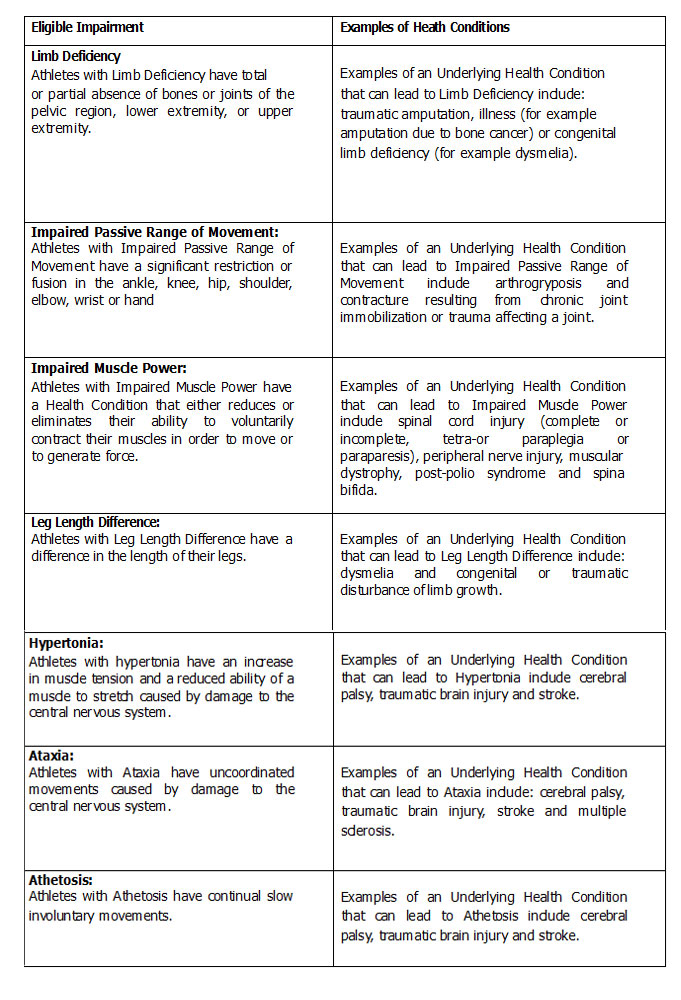 Appendix Two
1 Non-Eligible Impairment Types for all Athletes
Examples of Non-Eligible Impairments include, but are not limited to the following:
• Pain;
• Hearing impairment;
• Low muscle tone;
• Hypermobility of joints;
• Joint instability, such as unstable shoulder joint, recurrent dislocation of a joint;
• Impaired muscle endurance;
• Impaired motor reflex functions;
• Impaired cardiovascular functions;
• Impaired respiratory functions;
• Impairment metabolic functions; and
• Tics and mannerisms, stereotypes and motor perseveration.
2 Health Conditions that are not Underlying Health
Conditions for all Athletes
A number of Health Conditions do not lead to an Eligible Impairment and therefore are
not considered to be Underlying Health Conditions (see Glossary).
Health Conditions that primarily cause pain; primarily cause fatigue; primarily cause
joint hypermobility or hypotonia; or are primarily psychological or psychosomatic in
nature do not lead to an Eligible Impairment.
Examples of Health Conditions that primarily cause pain include myofascial pain-
dysfunction syndrome, fibromyalgia or complex regional pain syndrome. An athlete
may have these Health Conditions, but the presence of these Health Conditions in
isolation, do not lead to an Eligible Impairment.
An example of a Health Condition that primarily causes fatigue is chronic fatigue
syndrome.
An example of a Health Condition that primarily causes hypermobility or hypotonia is
Ehlers- Danlos syndrome.
Examples of Health Conditions that are primarily psychological or psychosomatic in
nature include conversion disorders or post-traumatic stress disorder.
Appendix Three
Sitting Volleyball
1 Minimum Impairment Criteria (MIC)
1.1 Minimum Impairment Criteria define how severe an athlete’s impairment must be
in order to be eligible for World ParaVolley Sport Disciplines.
1.2 World ParaVolley has Minimum Impairment Criteria for Sitting (and Sitting
Beach) Volleyball in Appendix 3:
• Impairments described in this section are considered to alter the biomechanical
execution of the core skills related to sitting volleyball in a way that is
demonstrable and which will adversely affect performance.
• The functions to be considered in Sitting Volleyball are as follows:
o Serving
o Digging
o Overhead Passing/Setting
o Spiking
o Blocking
o Diving/Stretching
o Moving on court in the sitting position
1.3 Minimum Impairment Criteria for Sport Discipline of Sitting Volleyball
1.3.1 Limb Deficiency
Limb deficiency may result from amputation (e.g. acquired due to trauma or diseases
such as bone cancer) or dysmelia, which is defined as a congenital abnormality
characterized by missing or foreshortened extremities. Each of the criteria below has
two components:
• A description of amputation meeting minimum impairment criteria
• A description of dysmelia meeting minimum impairment criteria.
1.3.1.1 Limb Deficiency – Lower Limb
Appendix Two
1 Non-Eligible Impairment Types for all Athletes
Examples of Non-Eligible Impairments include, but are not limited to the following:
• Pain;
• Hearing impairment;
• Low muscle tone;
• Hypermobility of joints;
• Joint instability, such as unstable shoulder joint, recurrent dislocation of a joint;
• Impaired muscle endurance;
• Impaired motor reflex functions;
• Impaired cardiovascular functions;
• Impaired respiratory functions;
• Impairment metabolic functions; and
• Tics and mannerisms, stereotypes and motor perseveration.
2 Health Conditions that are not Underlying Health
Conditions for all Athletes
A number of Health Conditions do not lead to an Eligible Impairment and therefore are
not considered to be Underlying Health Conditions (see Glossary).
Health Conditions that primarily cause pain; primarily cause fatigue; primarily cause
joint hypermobility or hypotonia; or are primarily psychological or psychosomatic in
nature do not lead to an Eligible Impairment.
Examples of Health Conditions that primarily cause pain include myofascial pain-
dysfunction syndrome, fibromyalgia or complex regional pain syndrome. An athlete
may have these Health Conditions, but the presence of these Health Conditions in
isolation, do not lead to an Eligible Impairment.
An example of a Health Condition that primarily causes fatigue is chronic fatigue
syndrome.
An example of a Health Condition that primarily causes hypermobility or hypotonia is
Ehlers- Danlos syndrome.
Examples of Health Conditions that are primarily psychological or psychosomatic in
nature include conversion disorders or post-traumatic stress disorder.
Appendix Three
Sitting Volleyball
1 Minimum Impairment Criteria (MIC)
1.1 Minimum Impairment Criteria define how severe an athlete’s impairment must be
in order to be eligible for World ParaVolley Sport Disciplines.
1.2 World ParaVolley has Minimum Impairment Criteria for Sitting (and Sitting
Beach) Volleyball in Appendix 3:
• Impairments described in this section are considered to alter the biomechanical
execution of the core skills related to sitting volleyball in a way that is
demonstrable and which will adversely affect performance.
• The functions to be considered in Sitting Volleyball are as follows:
o Serving
o Digging
o Overhead Passing/Setting
o Spiking
o Blocking
o Diving/Stretching
o Moving on court in the sitting position
1.3 Minimum Impairment Criteria for Sport Discipline of Sitting Volleyball
1.3.1 Limb Deficiency
Limb deficiency may result from amputation (e.g. acquired due to trauma or diseases
such as bone cancer) or dysmelia, which is defined as a congenital abnormality
characterized by missing or foreshortened extremities. Each of the criteria below has
two components:
• A description of amputation meeting minimum impairment criteria
• A description of dysmelia meeting minimum impairment criteria.
1.3.1.1 Limb Deficiency – Lower Limb
 1.3.1.2 Limb Deficiency – Upper Limb
1.3.1.2 Limb Deficiency – Upper Limb
 1.3.2 Impaired Passive Range of Movement (PROM)
Unless otherwise indicated, PROM should be assessed using the protocols described by
Clarkson (2). In brief, measurement of PROM requires the athlete to relax completely
while the classifier moves the joint of interest through the available range. The athlete
should be relaxed and not attempting voluntary movement during these tests
(reference).
1.3.2.1 Impaired PROM – Lower Limb
The Minimum Impairment Criteria for impaired PROM in the lower limbs is met if one lower
limb meets the following criteria:
1.3.2 Impaired Passive Range of Movement (PROM)
Unless otherwise indicated, PROM should be assessed using the protocols described by
Clarkson (2). In brief, measurement of PROM requires the athlete to relax completely
while the classifier moves the joint of interest through the available range. The athlete
should be relaxed and not attempting voluntary movement during these tests
(reference).
1.3.2.1 Impaired PROM – Lower Limb
The Minimum Impairment Criteria for impaired PROM in the lower limbs is met if one lower
limb meets the following criteria:
 1.3.2.2 Impaired PROM –Upper Limb
The Minimum Impairment Criteria for impaired PROM in the upper limbs is met if one
upper limb meets the following criteria:
1.3.2.2 Impaired PROM –Upper Limb
The Minimum Impairment Criteria for impaired PROM in the upper limbs is met if one
upper limb meets the following criteria:
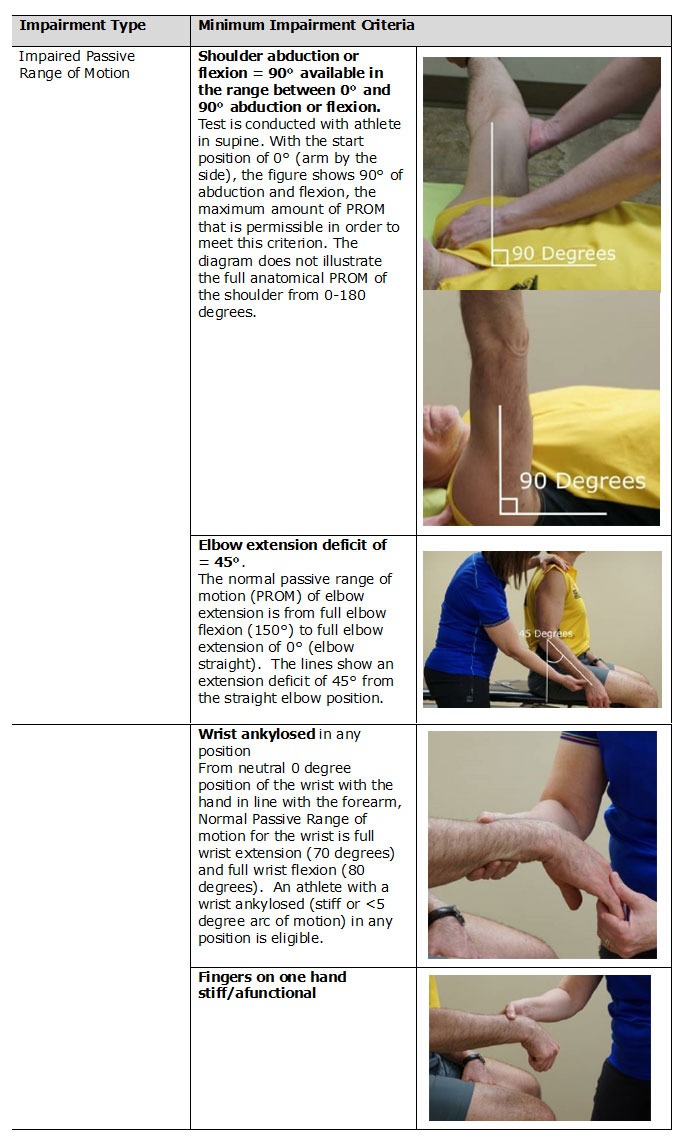 1.3.3 Impaired Muscle Power
Muscle power will be assessed according to the Daniels and Worthingham (D&W) scale
published in 2007 (3). See Appendix 2.2 for more detailed assessment methodology.
1.3.3.1 Impaired muscle power - Lower limb
Athletes are eligible if they meet the following criteria:
1.3.3 Impaired Muscle Power
Muscle power will be assessed according to the Daniels and Worthingham (D&W) scale
published in 2007 (3). See Appendix 2.2 for more detailed assessment methodology.
1.3.3.1 Impaired muscle power - Lower limb
Athletes are eligible if they meet the following criteria:
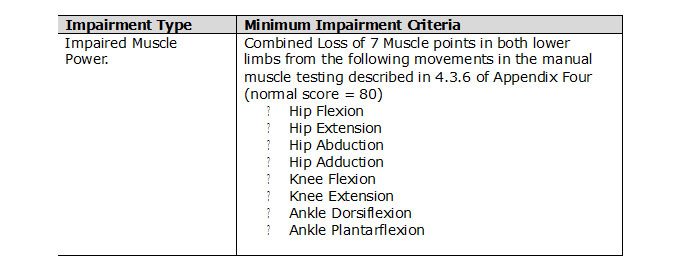 1.3.3.2 Impaired muscle power – Upper limb
Athletes are eligible if they meet the following criteria:
1.3.3.2 Impaired muscle power – Upper limb
Athletes are eligible if they meet the following criteria:
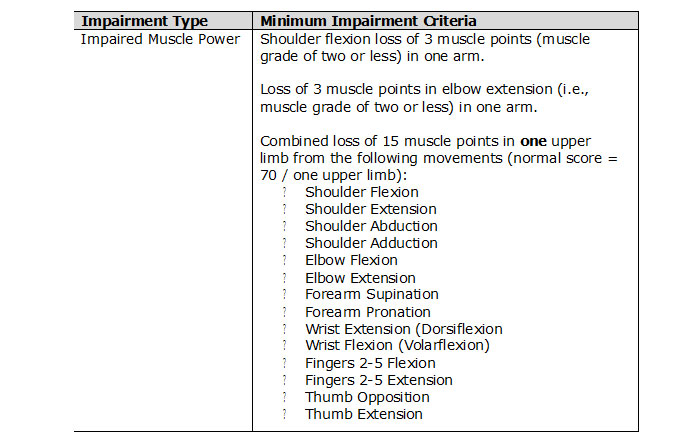 1.3.4 Limb Length Difference
The difference in length between right and left legs must be 7% or more, as measured
from the ASIS to the most inferior (caudal) point of the medial malleolus.
1.3.5 Hypertonia
Spasticity grades used in the World ParaVolley Rules & Regulations refer to the
Ashworth scale (1):
• Grade 0: No increase in tone
• Grade 1: Slight increase in tone giving a “catch” when the limb is flexed or extended
• Grade 2: More marked increase in tone, but limb is easily flexed or extended
• Grade 3: Considerable increase in tone with passive movement difficult
• Grade 4: Limb rigid in flexion or extension
Hypertonia is defined as increased muscle tone which is caused by central nervous
system impairment and which results in increased resistance to passive lengthening of
the muscle (4).
One of the following types of hypertonia must be clearly clinically detectable – (i.e.,
grade 1 on the Ashworth scale (1) at the wrist, elbow, or shoulder for the upper limb,
or grade I at the ankle plus the knee or hip).
• Spastic Hypertonia
• Rigidity
• Dystonia
An athlete who does not have one of the three types of Hypertonia – Spasticity, Rigidity
or Dystonia – is not eligible.
The Classification Panel should be satisfied that the resistance to passive lengthening of
the muscle is due to central nervous system impairment and the following signs may be
useful in this regard:
• Presence of non-damping clonus on the side on which the tone is increased;
• Abnormally brisk reflexes in the limb in which the tone is increased;
• Mild atrophy in the limb in which the tone is increased;
• Positive Babinski on the side in which the tone is increased.
1.3.6 Ataxia
Ataxia refers to an unsteadiness, incoordination or clumsiness of volitional movement
(4). Eligible ataxias must result from either motor or sensory nervous system
dysfunction. Motor ataxias most frequently result from malformation or damage to the
cerebellum and are often associated with hypotonia (4). Motor ataxias are poorly
compensated for by visual input.
Sensory ataxias most frequently result from lower motor neuron damage or spinal cord
disease, affecting vestibular function or proprioceptive function. Visual input can help
compensate for sensory ataxia and so sensory ataxias are often more evident when
eyes are closed (4).
When evaluating an athlete the Classification Panel should be satisfied that the ataxic
movement is demonstrable and clearly evident during classification and that the
observed ataxia is due to motor or sensory nervous system dysfunction as described.
Tests that may be useful for determining this include but are not limited to:
• Finger-to-nose test (athlete touching own nose from the crucifix position);
• Finger-to-finger test (classifier presents his/her index finger and asks the athlete
to touch it with his/her own index finger);
• Toe-to-finger test (classifier presents his/her index finger and asks the athlete to
touch it with his/her toe);
• Heel shin test (i.e., draw the heel of one leg along the length of the contralateral
shin, from ankle to knee and then in the reverse direction);
• Tandem walk;
• Gait.
1.3.7 Athetosis
Athetosis refers to unwanted movement and posturing resulting from damage to motor
control centres of the brain, most frequently the basal ganglia. When evaluating an
athlete the Classification Panel should satisfy itself that athetosis is clearly evident and
that it is neurological in origin. Clearly evident athetosis is unwanted movement and
posturing that is characteristically athetoid and is observable as at least one of the
following:
• Involuntary movement of the fingers or upper extremities despite the athlete
trying to remain still;
• Involuntary movement of the toes or lower extremities despite the athlete trying
to remain still;
• Inability to hold the body still – swaying of the body. Swaying should not be due
to other neurological deficits such as vestibular or proprioceptive impairments
and therefore should not be exacerbated by closing of the eyes;
• Characteristic athetoid posturing of limbs and/or trunk;
The Athlete will not be eligible if athetoid movements of the face are the sole
impairment.
For 1.3.5 – 1.3.7: The Athlete must demonstrate an activity limitation based on
evidence of spasticity (increased tone), ataxic, athetoid or dystonic movements both off
court and while performing core volleyball functions on court.
e.g. CP-ISRA - Class 8
“Athletes are minimally affected diplegic, hemiplegic, and monoplegic or have minimal
movement control patterns. They will run without noticeable limp but disability will be
more evident on exertion, however the athlete must demonstrate evidence of a
functional disability during testing. Players with minimal involvement may appear to
have near normal function when running but the player must demonstrate a limitation
in function to classifiers based on evidence of spasticity (increased tone), ataxic,
athetoid or dystonic movements while performing on the field of play. Some players
with an acquired brain injury, the dominant side may be the impaired side.
2 Assessment Methodology
2.1 Limb Deficiency
2.1.1 Note: In terms of Anthropometric measurements, the average of two (2)
measures is taken. If the difference between these two (2) measures is greater
than 1%, one additional measure is taken, and the median measure is
recorded on the Classification sheet as the measurement.
2.1.2 In measuring the upper limb deficiency, a measurement is taken from the
acromion to the tip of the longest finger (or radial styloid if assessing length of
BEA stump)
2.2 Impaired Passive Range of Movement (PROM)
2.2.1 Unless otherwise indicated, PROM should be assessed using the protocols
described by Clarkson (2). In brief, measurement of PROM requires the athlete
to relax completely while the classifier moves the joint of interest through the
available range. The athlete should be relaxed and not attempting voluntary
movement during these tests. PROM testing must be conducted using a
goniometer.
2.3 Impaired Muscle Power - Manual Muscle Testing
2.3.1 The following movements should be tested by the classifiers when conducting
testing for impaired muscle power involving the upper or lower limbs:
1.3.4 Limb Length Difference
The difference in length between right and left legs must be 7% or more, as measured
from the ASIS to the most inferior (caudal) point of the medial malleolus.
1.3.5 Hypertonia
Spasticity grades used in the World ParaVolley Rules & Regulations refer to the
Ashworth scale (1):
• Grade 0: No increase in tone
• Grade 1: Slight increase in tone giving a “catch” when the limb is flexed or extended
• Grade 2: More marked increase in tone, but limb is easily flexed or extended
• Grade 3: Considerable increase in tone with passive movement difficult
• Grade 4: Limb rigid in flexion or extension
Hypertonia is defined as increased muscle tone which is caused by central nervous
system impairment and which results in increased resistance to passive lengthening of
the muscle (4).
One of the following types of hypertonia must be clearly clinically detectable – (i.e.,
grade 1 on the Ashworth scale (1) at the wrist, elbow, or shoulder for the upper limb,
or grade I at the ankle plus the knee or hip).
• Spastic Hypertonia
• Rigidity
• Dystonia
An athlete who does not have one of the three types of Hypertonia – Spasticity, Rigidity
or Dystonia – is not eligible.
The Classification Panel should be satisfied that the resistance to passive lengthening of
the muscle is due to central nervous system impairment and the following signs may be
useful in this regard:
• Presence of non-damping clonus on the side on which the tone is increased;
• Abnormally brisk reflexes in the limb in which the tone is increased;
• Mild atrophy in the limb in which the tone is increased;
• Positive Babinski on the side in which the tone is increased.
1.3.6 Ataxia
Ataxia refers to an unsteadiness, incoordination or clumsiness of volitional movement
(4). Eligible ataxias must result from either motor or sensory nervous system
dysfunction. Motor ataxias most frequently result from malformation or damage to the
cerebellum and are often associated with hypotonia (4). Motor ataxias are poorly
compensated for by visual input.
Sensory ataxias most frequently result from lower motor neuron damage or spinal cord
disease, affecting vestibular function or proprioceptive function. Visual input can help
compensate for sensory ataxia and so sensory ataxias are often more evident when
eyes are closed (4).
When evaluating an athlete the Classification Panel should be satisfied that the ataxic
movement is demonstrable and clearly evident during classification and that the
observed ataxia is due to motor or sensory nervous system dysfunction as described.
Tests that may be useful for determining this include but are not limited to:
• Finger-to-nose test (athlete touching own nose from the crucifix position);
• Finger-to-finger test (classifier presents his/her index finger and asks the athlete
to touch it with his/her own index finger);
• Toe-to-finger test (classifier presents his/her index finger and asks the athlete to
touch it with his/her toe);
• Heel shin test (i.e., draw the heel of one leg along the length of the contralateral
shin, from ankle to knee and then in the reverse direction);
• Tandem walk;
• Gait.
1.3.7 Athetosis
Athetosis refers to unwanted movement and posturing resulting from damage to motor
control centres of the brain, most frequently the basal ganglia. When evaluating an
athlete the Classification Panel should satisfy itself that athetosis is clearly evident and
that it is neurological in origin. Clearly evident athetosis is unwanted movement and
posturing that is characteristically athetoid and is observable as at least one of the
following:
• Involuntary movement of the fingers or upper extremities despite the athlete
trying to remain still;
• Involuntary movement of the toes or lower extremities despite the athlete trying
to remain still;
• Inability to hold the body still – swaying of the body. Swaying should not be due
to other neurological deficits such as vestibular or proprioceptive impairments
and therefore should not be exacerbated by closing of the eyes;
• Characteristic athetoid posturing of limbs and/or trunk;
The Athlete will not be eligible if athetoid movements of the face are the sole
impairment.
For 1.3.5 – 1.3.7: The Athlete must demonstrate an activity limitation based on
evidence of spasticity (increased tone), ataxic, athetoid or dystonic movements both off
court and while performing core volleyball functions on court.
e.g. CP-ISRA - Class 8
“Athletes are minimally affected diplegic, hemiplegic, and monoplegic or have minimal
movement control patterns. They will run without noticeable limp but disability will be
more evident on exertion, however the athlete must demonstrate evidence of a
functional disability during testing. Players with minimal involvement may appear to
have near normal function when running but the player must demonstrate a limitation
in function to classifiers based on evidence of spasticity (increased tone), ataxic,
athetoid or dystonic movements while performing on the field of play. Some players
with an acquired brain injury, the dominant side may be the impaired side.
2 Assessment Methodology
2.1 Limb Deficiency
2.1.1 Note: In terms of Anthropometric measurements, the average of two (2)
measures is taken. If the difference between these two (2) measures is greater
than 1%, one additional measure is taken, and the median measure is
recorded on the Classification sheet as the measurement.
2.1.2 In measuring the upper limb deficiency, a measurement is taken from the
acromion to the tip of the longest finger (or radial styloid if assessing length of
BEA stump)
2.2 Impaired Passive Range of Movement (PROM)
2.2.1 Unless otherwise indicated, PROM should be assessed using the protocols
described by Clarkson (2). In brief, measurement of PROM requires the athlete
to relax completely while the classifier moves the joint of interest through the
available range. The athlete should be relaxed and not attempting voluntary
movement during these tests. PROM testing must be conducted using a
goniometer.
2.3 Impaired Muscle Power - Manual Muscle Testing
2.3.1 The following movements should be tested by the classifiers when conducting
testing for impaired muscle power involving the upper or lower limbs:
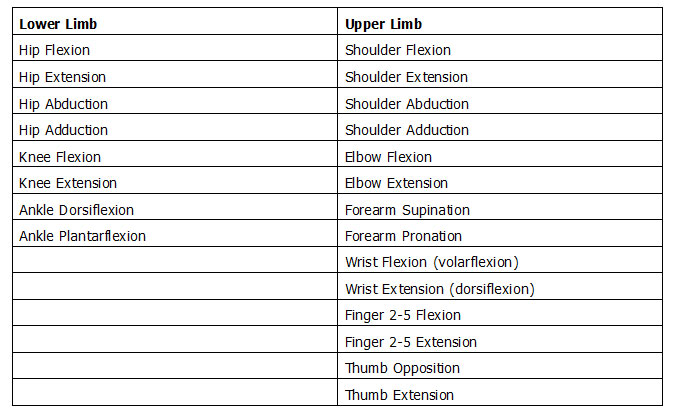 2.3.2: Muscle power will be assessed according to the Daniels and Worthingham (D&W)
(3) scale published in 2007. The scale has 6 levels, from 0-5:
• 5: normal muscle power through available ROM
• 4: active movement through available ROM, against gravity plus some
resistance
• 3: active movement through full available ROM against gravity but no resistance
• 2: active movement with gravity eliminated (some movement against gravity
may be possible, but not full range);
• 1: trace muscle activity but no movement of the limb
• 0: No muscle activity
This scale will be used with one modification: The Scores 0,1 and 2 of the Daniel and
Worthingham scale are all captured as a score of 0. As well, ankle plantarflexion strength
testing has been modified.
2.3.3 The above grades of muscle power are based on the concept that the grades are
given for full active/passive ROM with the given amount of resistance, while loss of ROM
(active or passive) does affect the ability of a muscle to generate force and function. The
guidelines below should be considered for adjustments to the muscle grade with testing:
• ¾ - full ROM – muscle grade given
• ½ - ¾ ROM – muscle grade minus 1 point
• ¼ - ½ ROM - muscle grade minus 2 points
• 0 – ¼ ROM – muscle grade minus 3 points
2.3.4 PAIN cannot be taken into account in classification grading.
Muscle strength must be graded as a 5/5 if pain interferes with the testing.
2.3.5 Measurements are to be taken in the primary test position unless athlete is unable
to be tested in the primary position. In this case, an alternative position may be used.
2.3.6
2.3.2: Muscle power will be assessed according to the Daniels and Worthingham (D&W)
(3) scale published in 2007. The scale has 6 levels, from 0-5:
• 5: normal muscle power through available ROM
• 4: active movement through available ROM, against gravity plus some
resistance
• 3: active movement through full available ROM against gravity but no resistance
• 2: active movement with gravity eliminated (some movement against gravity
may be possible, but not full range);
• 1: trace muscle activity but no movement of the limb
• 0: No muscle activity
This scale will be used with one modification: The Scores 0,1 and 2 of the Daniel and
Worthingham scale are all captured as a score of 0. As well, ankle plantarflexion strength
testing has been modified.
2.3.3 The above grades of muscle power are based on the concept that the grades are
given for full active/passive ROM with the given amount of resistance, while loss of ROM
(active or passive) does affect the ability of a muscle to generate force and function. The
guidelines below should be considered for adjustments to the muscle grade with testing:
• ¾ - full ROM – muscle grade given
• ½ - ¾ ROM – muscle grade minus 1 point
• ¼ - ½ ROM - muscle grade minus 2 points
• 0 – ¼ ROM – muscle grade minus 3 points
2.3.4 PAIN cannot be taken into account in classification grading.
Muscle strength must be graded as a 5/5 if pain interferes with the testing.
2.3.5 Measurements are to be taken in the primary test position unless athlete is unable
to be tested in the primary position. In this case, an alternative position may be used.
2.3.6
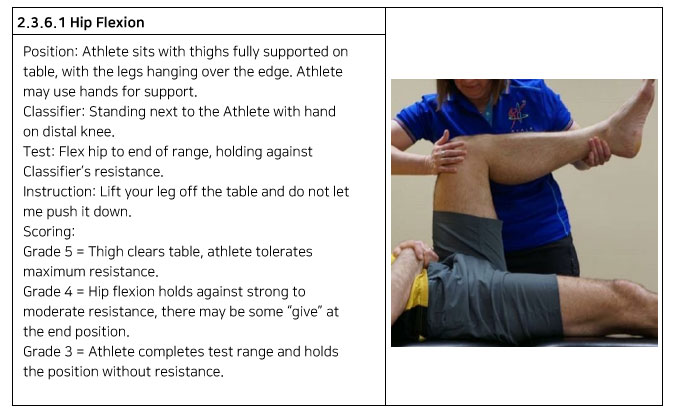
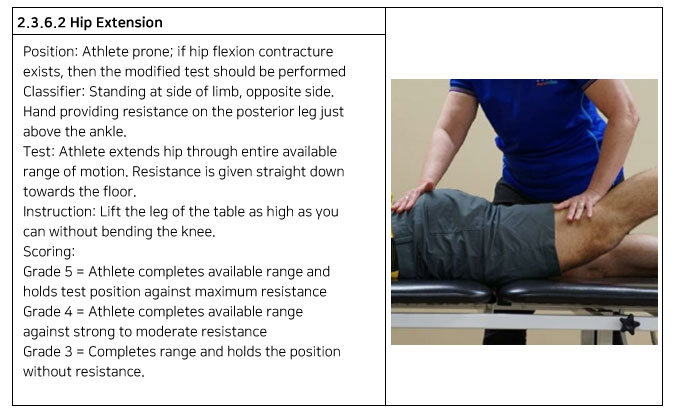

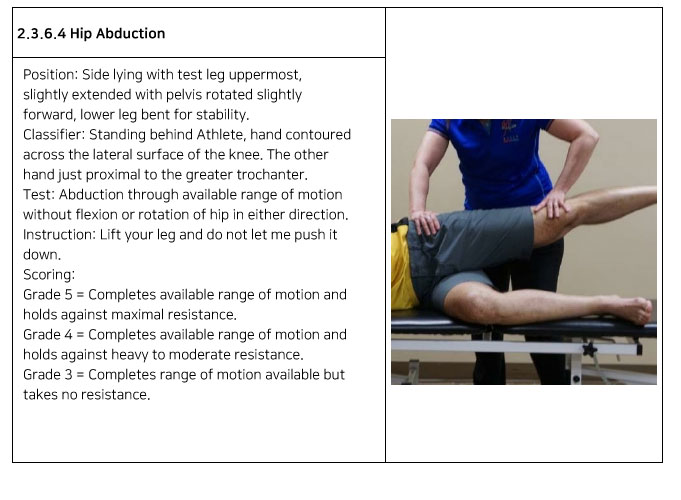
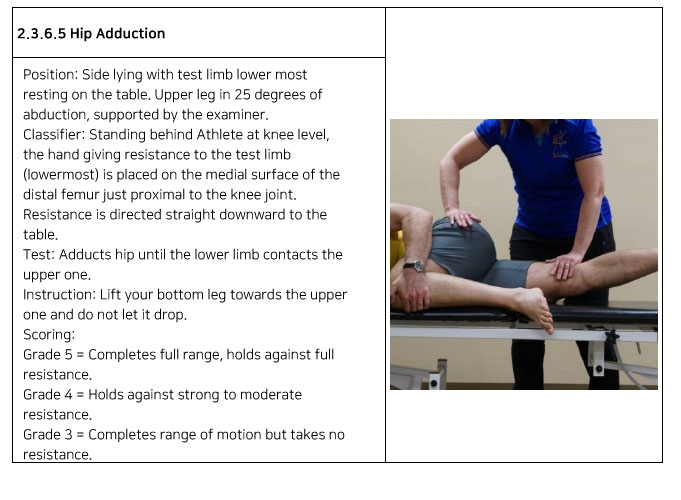
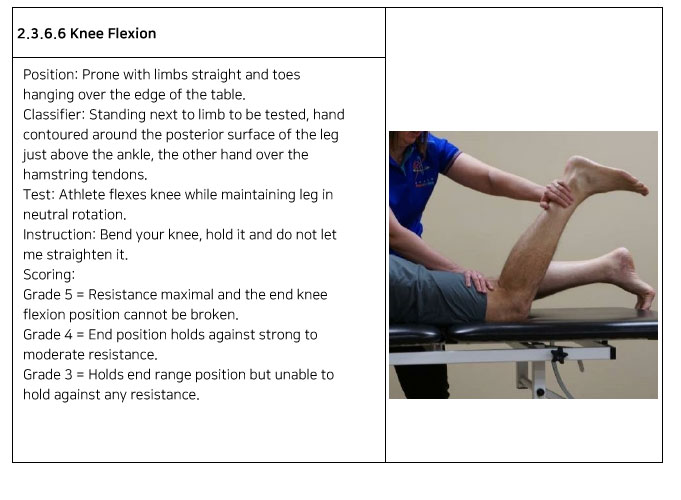
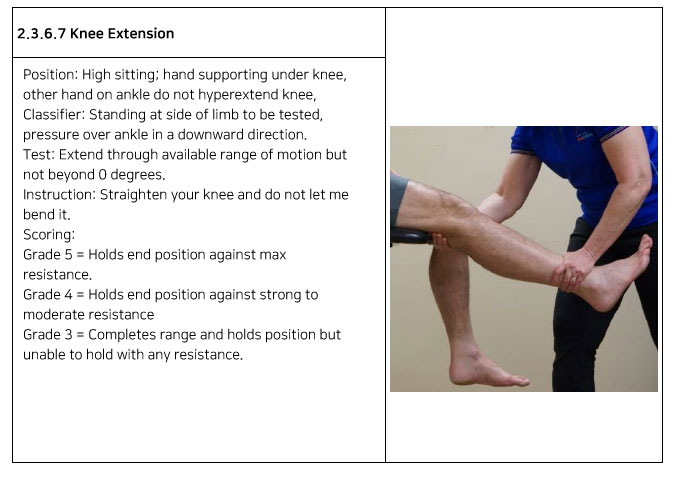
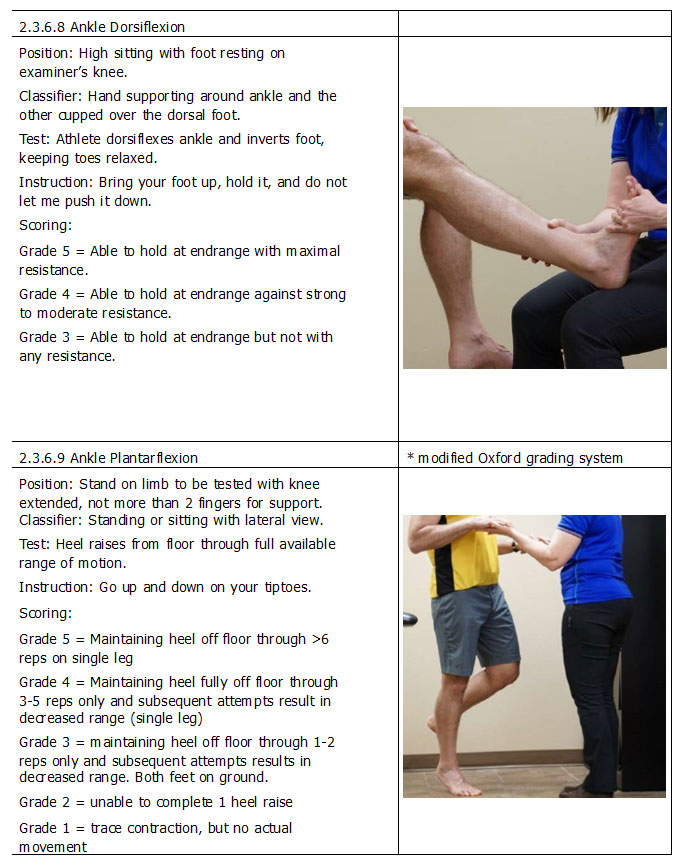

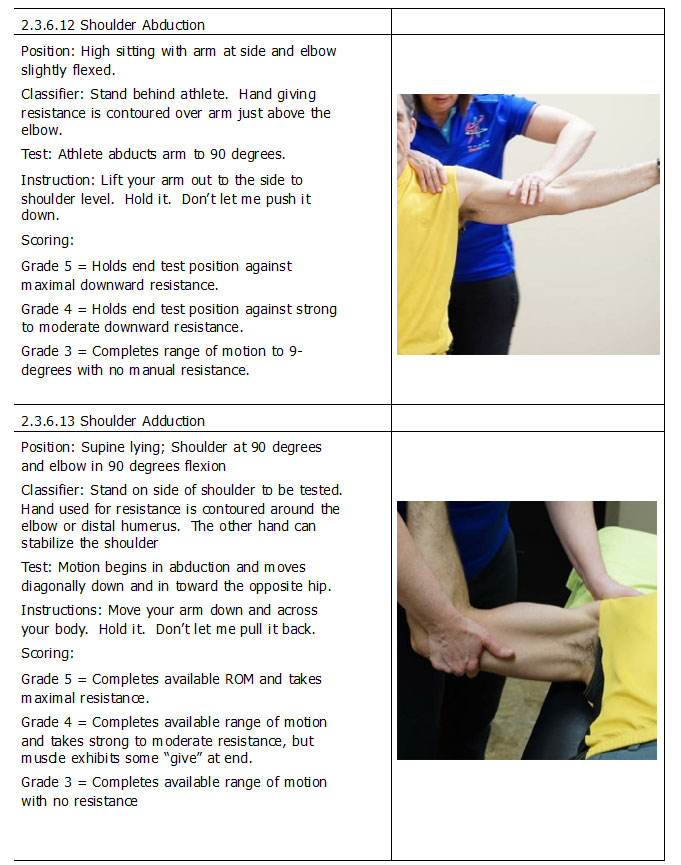
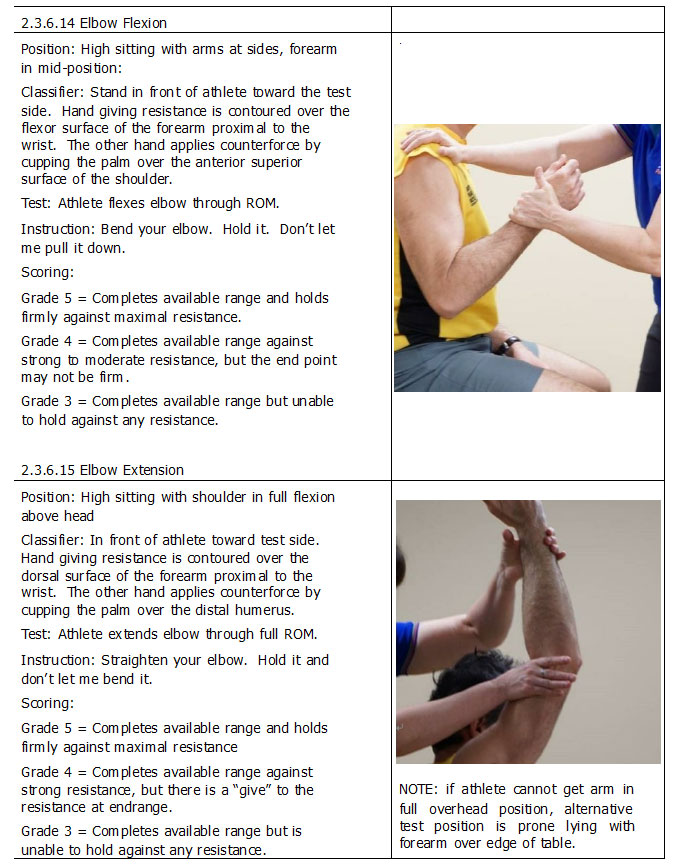
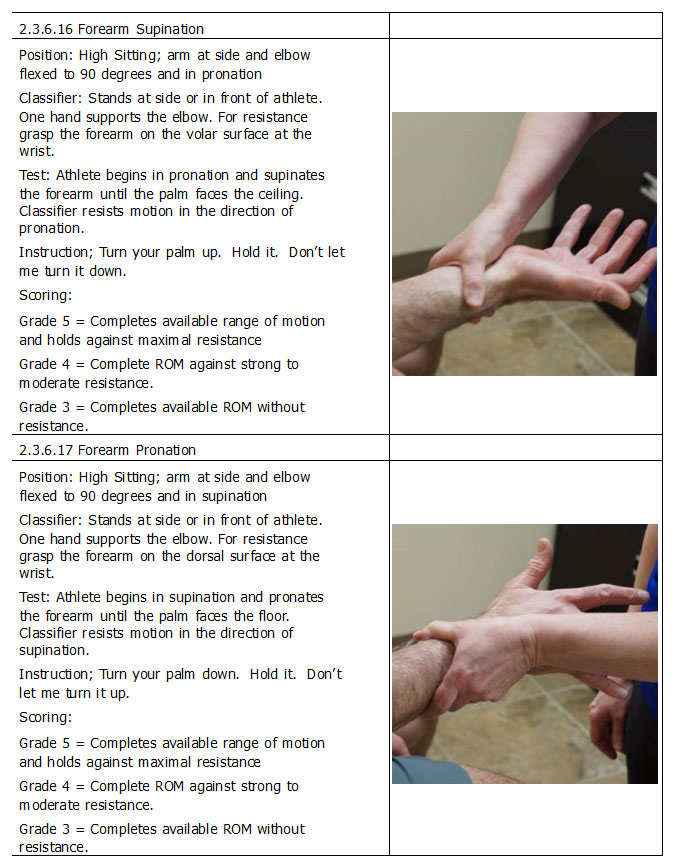
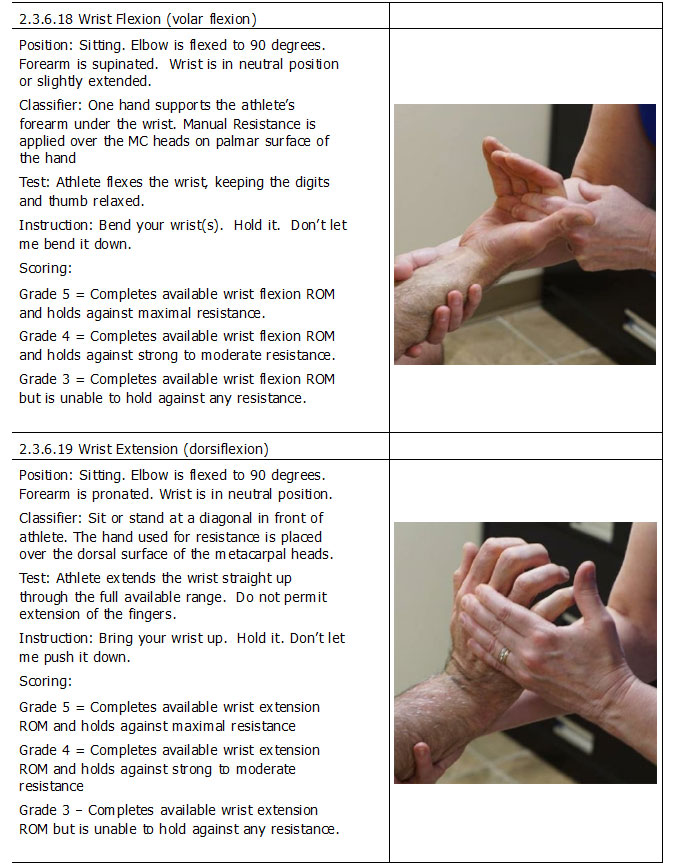
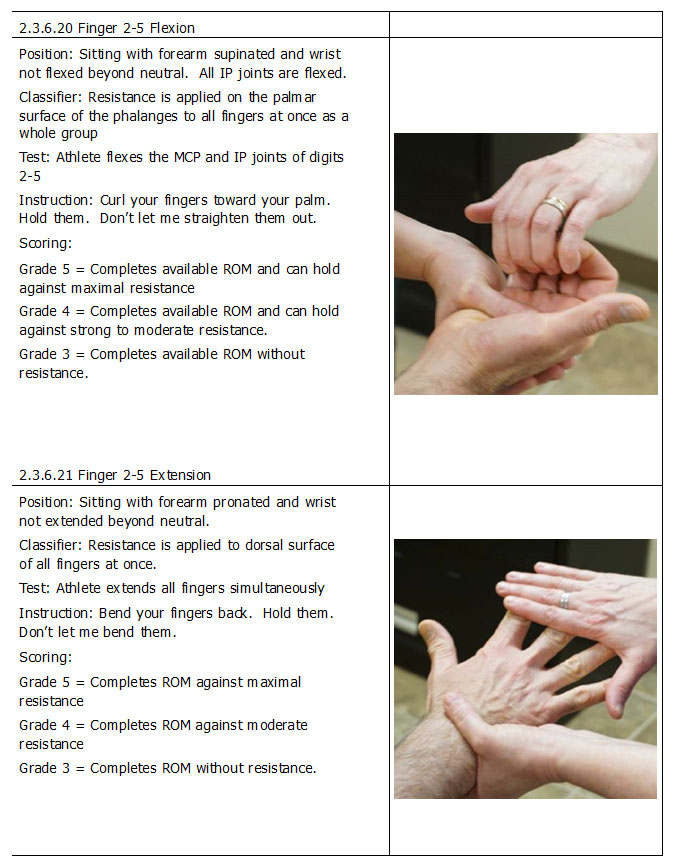
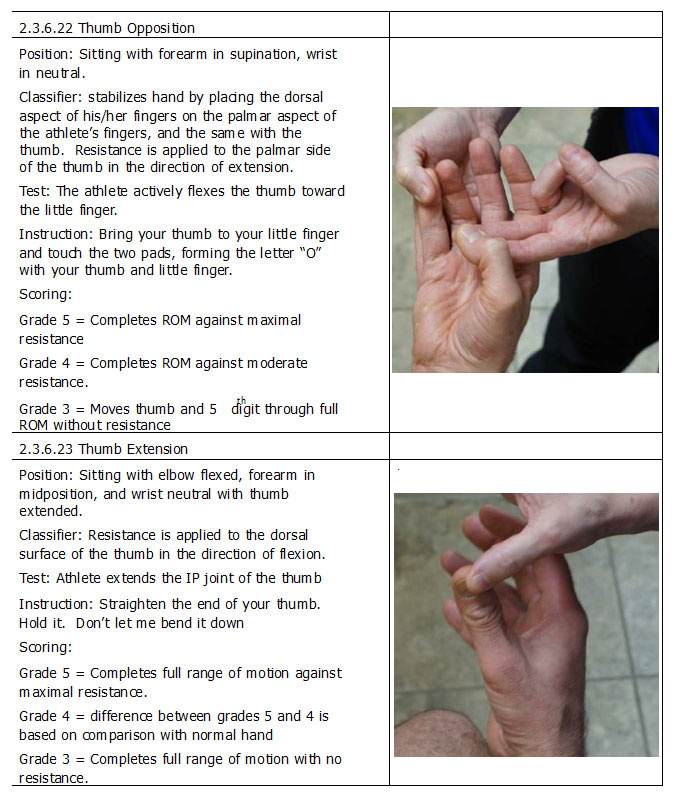 2.4 Leg Length Difference
2.4.1 To measure, the athlete should lie supine with legs relaxed and fully extended.
Measure from the inferior aspect of the anterior superior iliac spine to the inferior aspect
of the tip of the medial malleolus on each leg and then compare.
2.4.2 The difference in leg length is expressed as a percentage:
(SHORT LIMB/UNAFFECTED LIMB) x 100
Note: In terms of Anthropometric measurements, the average of two (2) measures is
taken. If the difference between these two (2) measures is greater than 1%, one
additional measure is taken,
and the median measure is recorded on the Classification sheet as the
measurement.
2.5 Hypertonia
Spasticity grades used in the World ParaVolley Rules & Regulations refer to the Ashworth
scale (1):
• Grade 0: No increase in tone
• Grade 1: Slight increase in tone giving a “catch” when the limb is flexed or
extended
• Grade 2: More marked increase in tone, but limb is easily flexed or extended
• Grade 3: Considerable increase in tone with passive movement difficult
• Grade 4: Limb rigid in flexion or extension
Hypertonia is defined as increased muscle tone which is caused by central nervous
system impairment and which results in increased resistance to passive lengthening of
the muscle (4).
One of the following types of hypertonia must be clearly clinically detectable – i.e., grade
1 on the Ashworth scale (1) at the wrist, elbow, and shoulder for the upper limb, or
grade I at the ankle and knee or hip.
2.5.1 Spastic hypertonia: Is defined as a velocity-dependent resistance to passive
movement with a clasp-knife type of resistance (4). Clasp-knife resistance is resistance
that is initially high and followed by a sudden relaxation. Velocity dependence increases
as the speed of the passive movement increases, the resistance becomes greater and
starts earlier in the range.
Spastic hypertonicity tends to predominate in the antigravity muscles particularly the
flexors of the arms and extensors of the legs and may affect certain parts of the body
more than others. In classification, testing for Spastic hypertonicity involves rapid,
passive movement through the principal ranges of movement at the wrist, elbow,
shoulder, ankle, knee or hip.
When testing for Spastic hypertonicity at the ankle or wrist, clonus may be elicited.
Clonus is rapid, involuntary alternation of muscle contraction and relaxation and typically
occurs in the ankle plantar flexors in response to rapid, passive dorsiflexion or the wrist
flexors in response to rapid, passive wrist extension.
Clonus that lasts for 4 beats or more and which can be reliably reproduced during a
single classification session (i.e., is non-damping clonus) is considered to indicate
presence of Spastic hypertonicity that meets the MDC.
2.5.2 Rigidity: Is defined as a heightened resistance to passive movement of a limb that
is independent of the velocity of stretch and relatively uniform throughout the range of
motion of that limb (4). The uniform resistance is often referred to as ‘lead pipe’ type of
resistance. Usually has a predominant pattern with a flexor pattern being more common.
2.5.3 Dystonia: Is resistance to passive movement that may be focal (affecting muscles
of one limb or joint) or general (affecting the whole body). Contractions are powerful
and sustained and cause twisting or writhing of the affected areas*. The pattern is
highly variable – contractions may be fast or slow; painful or not; and the direction of
greatest resistance may change regularly (e.g., a limb may move regularly from an
extreme flexion pattern to an extreme extension pattern) (4, 10).
*As the description indicates, Dystonia may equally be classified as a type of Hypertonia
OR a type of involuntary movement pattern.
An athlete who does not have one of the three types of Hypertonia – Spasticity, Rigidity
or Dystonia – is not eligible.
The Classification Panel should be satisfied that the resistance to passive lengthening of
the muscle is due to central nervous system impairment and the following signs may be
useful in this regard:
• Presence of non-damping clonus on the side on which the tone is increased;
• Abnormally brisk reflexes in the limb in which the tone is increased;
• Mild atrophy in the limb in which the tone is increased;
• Positive Babinski on the side in which the tone is increased.
2.6 Ataxia
Ataxia refers to an unsteadiness, incoordination or clumsiness of volitional movement (4). Eligible ataxias must result from either motor or sensory nervous system
dysfunction. Motor ataxias most frequently result from malformation or damage to the cerebellum and are often associated with hypotonia (4). Motor ataxias are poorly
compensated for by visual input. Sensory ataxias most frequently result from lower motor neuron damage or spinal cord disease, affecting vestibular function or proprioceptive function. Visual input can help compensate for sensory ataxia and so sensory ataxias are often more evident when eye are closed (4).
When evaluating an athlete the Classification Panel should be satisfied that the ataxic
movement is demonstrable and clearly evident during classification and that the
observed ataxia is due to motor or sensory nervous system dysfunction as described.
Tests that may be useful for determining this include but are not limited to:
• Finger-to-nose test (athlete touching own nose from the crucifix position);
• Finger-to-finger test (classifier presents his/her index finger and asks the athlete
to touch it with his/her own index finger);
• Toe-to-finger test (classifier presents his/her index finger and asks the athlete to
touch it with his/her toe);
• Heel shin test (i.e., draw the heel of one leg along the length of the contralateral
shin, from ankle to knee and then in the reverse direction);
• Tandem walk;
• Gait.
2.7 Athetosis
Athetosis refers to unwanted movement and posturing resulting from damage to motor control centres of the brain, most frequently the basal ganglia. When evaluating an athlete the Classification Panel should satisfy itself that athetosis is clearly evident and that it is neurological in origin. Clearly evident athetosis is unwanted movement and posturing that is characteristically athetoid and is observable as at least one of the following:
• Involuntary movement of the fingers or upper extremities despite the athlete trying to remain still;
• Involuntary movement of the toes or lower extremities despite the athlete trying to remain still;
• Inability to hold the body still – swaying of the body. Swaying should not be due to other neurological deficits such as vestibular or proprioceptive impairments and therefore should not be exacerbated by closing of the eyes;
• Characteristic athetoid posturing of limbs and/or trunk;
The athlete will not be eligible if athetoid movements of the face are the sole
impairment.
3 Assessment Criteria for the Allocation of a Sport Class and the Designation of Sport Class Status
3.1 The Sport Discipline of Sitting Volleyball has two sport classes, VS1 and VS2.
3.1.1 Athletes in the Sport Class VS1
These athletes have impairments that more significantly affect the core functions in sitting volleyball.
2.4 Leg Length Difference
2.4.1 To measure, the athlete should lie supine with legs relaxed and fully extended.
Measure from the inferior aspect of the anterior superior iliac spine to the inferior aspect
of the tip of the medial malleolus on each leg and then compare.
2.4.2 The difference in leg length is expressed as a percentage:
(SHORT LIMB/UNAFFECTED LIMB) x 100
Note: In terms of Anthropometric measurements, the average of two (2) measures is
taken. If the difference between these two (2) measures is greater than 1%, one
additional measure is taken,
and the median measure is recorded on the Classification sheet as the
measurement.
2.5 Hypertonia
Spasticity grades used in the World ParaVolley Rules & Regulations refer to the Ashworth
scale (1):
• Grade 0: No increase in tone
• Grade 1: Slight increase in tone giving a “catch” when the limb is flexed or
extended
• Grade 2: More marked increase in tone, but limb is easily flexed or extended
• Grade 3: Considerable increase in tone with passive movement difficult
• Grade 4: Limb rigid in flexion or extension
Hypertonia is defined as increased muscle tone which is caused by central nervous
system impairment and which results in increased resistance to passive lengthening of
the muscle (4).
One of the following types of hypertonia must be clearly clinically detectable – i.e., grade
1 on the Ashworth scale (1) at the wrist, elbow, and shoulder for the upper limb, or
grade I at the ankle and knee or hip.
2.5.1 Spastic hypertonia: Is defined as a velocity-dependent resistance to passive
movement with a clasp-knife type of resistance (4). Clasp-knife resistance is resistance
that is initially high and followed by a sudden relaxation. Velocity dependence increases
as the speed of the passive movement increases, the resistance becomes greater and
starts earlier in the range.
Spastic hypertonicity tends to predominate in the antigravity muscles particularly the
flexors of the arms and extensors of the legs and may affect certain parts of the body
more than others. In classification, testing for Spastic hypertonicity involves rapid,
passive movement through the principal ranges of movement at the wrist, elbow,
shoulder, ankle, knee or hip.
When testing for Spastic hypertonicity at the ankle or wrist, clonus may be elicited.
Clonus is rapid, involuntary alternation of muscle contraction and relaxation and typically
occurs in the ankle plantar flexors in response to rapid, passive dorsiflexion or the wrist
flexors in response to rapid, passive wrist extension.
Clonus that lasts for 4 beats or more and which can be reliably reproduced during a
single classification session (i.e., is non-damping clonus) is considered to indicate
presence of Spastic hypertonicity that meets the MDC.
2.5.2 Rigidity: Is defined as a heightened resistance to passive movement of a limb that
is independent of the velocity of stretch and relatively uniform throughout the range of
motion of that limb (4). The uniform resistance is often referred to as ‘lead pipe’ type of
resistance. Usually has a predominant pattern with a flexor pattern being more common.
2.5.3 Dystonia: Is resistance to passive movement that may be focal (affecting muscles
of one limb or joint) or general (affecting the whole body). Contractions are powerful
and sustained and cause twisting or writhing of the affected areas*. The pattern is
highly variable – contractions may be fast or slow; painful or not; and the direction of
greatest resistance may change regularly (e.g., a limb may move regularly from an
extreme flexion pattern to an extreme extension pattern) (4, 10).
*As the description indicates, Dystonia may equally be classified as a type of Hypertonia
OR a type of involuntary movement pattern.
An athlete who does not have one of the three types of Hypertonia – Spasticity, Rigidity
or Dystonia – is not eligible.
The Classification Panel should be satisfied that the resistance to passive lengthening of
the muscle is due to central nervous system impairment and the following signs may be
useful in this regard:
• Presence of non-damping clonus on the side on which the tone is increased;
• Abnormally brisk reflexes in the limb in which the tone is increased;
• Mild atrophy in the limb in which the tone is increased;
• Positive Babinski on the side in which the tone is increased.
2.6 Ataxia
Ataxia refers to an unsteadiness, incoordination or clumsiness of volitional movement (4). Eligible ataxias must result from either motor or sensory nervous system
dysfunction. Motor ataxias most frequently result from malformation or damage to the cerebellum and are often associated with hypotonia (4). Motor ataxias are poorly
compensated for by visual input. Sensory ataxias most frequently result from lower motor neuron damage or spinal cord disease, affecting vestibular function or proprioceptive function. Visual input can help compensate for sensory ataxia and so sensory ataxias are often more evident when eye are closed (4).
When evaluating an athlete the Classification Panel should be satisfied that the ataxic
movement is demonstrable and clearly evident during classification and that the
observed ataxia is due to motor or sensory nervous system dysfunction as described.
Tests that may be useful for determining this include but are not limited to:
• Finger-to-nose test (athlete touching own nose from the crucifix position);
• Finger-to-finger test (classifier presents his/her index finger and asks the athlete
to touch it with his/her own index finger);
• Toe-to-finger test (classifier presents his/her index finger and asks the athlete to
touch it with his/her toe);
• Heel shin test (i.e., draw the heel of one leg along the length of the contralateral
shin, from ankle to knee and then in the reverse direction);
• Tandem walk;
• Gait.
2.7 Athetosis
Athetosis refers to unwanted movement and posturing resulting from damage to motor control centres of the brain, most frequently the basal ganglia. When evaluating an athlete the Classification Panel should satisfy itself that athetosis is clearly evident and that it is neurological in origin. Clearly evident athetosis is unwanted movement and posturing that is characteristically athetoid and is observable as at least one of the following:
• Involuntary movement of the fingers or upper extremities despite the athlete trying to remain still;
• Involuntary movement of the toes or lower extremities despite the athlete trying to remain still;
• Inability to hold the body still – swaying of the body. Swaying should not be due to other neurological deficits such as vestibular or proprioceptive impairments and therefore should not be exacerbated by closing of the eyes;
• Characteristic athetoid posturing of limbs and/or trunk;
The athlete will not be eligible if athetoid movements of the face are the sole
impairment.
3 Assessment Criteria for the Allocation of a Sport Class and the Designation of Sport Class Status
3.1 The Sport Discipline of Sitting Volleyball has two sport classes, VS1 and VS2.
3.1.1 Athletes in the Sport Class VS1
These athletes have impairments that more significantly affect the core functions in sitting volleyball.
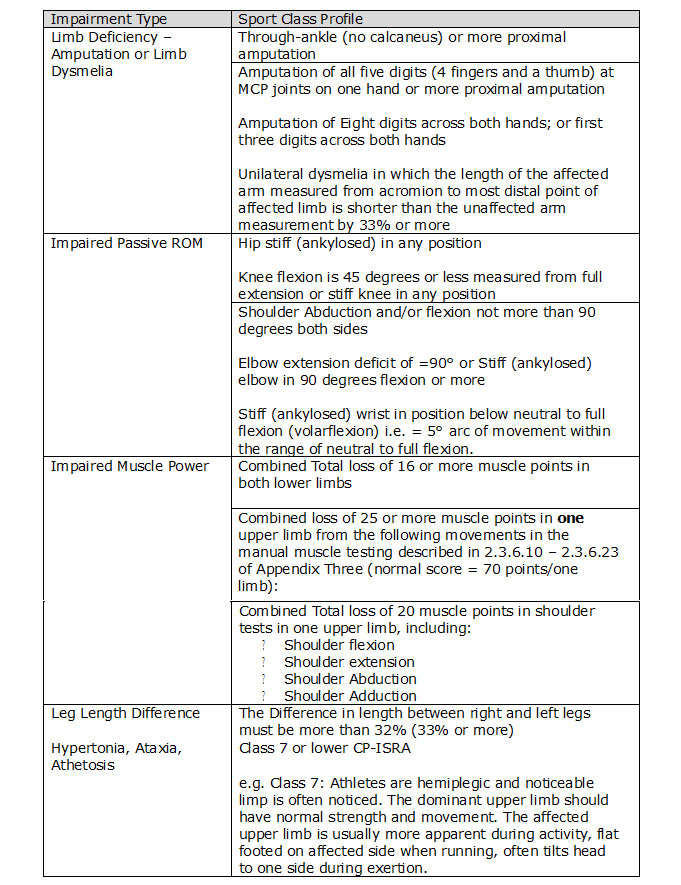 3.1.2 Athletes in Sport Class VS2
These athletes have impairments that minimally affect the core functions in sitting volleyball.
3.1.2 Athletes in Sport Class VS2
These athletes have impairments that minimally affect the core functions in sitting volleyball.
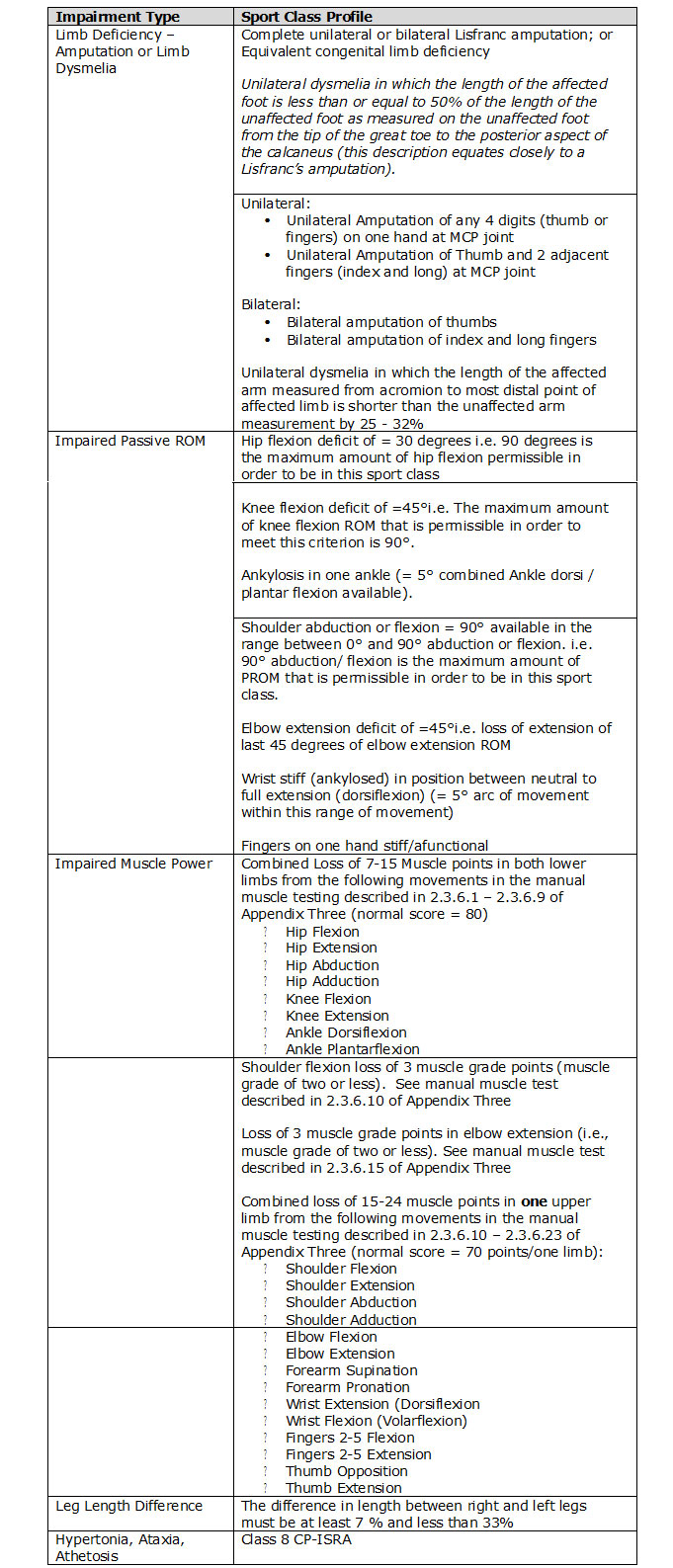 Appendix Four
1 Observation in Competition Assessment
Athletes that play with Eligible Impairments of Amputation or Limb Shortening are not required to undergo observation in Competition Assessment.
Athletes who are borderline between classes and who have Eligible Impairments that are not from amputation or Limb Shortening must undergo observation in competition
Assessment. Athletes are observed on court to ensure that the athlete demonstrates abilities on court that are consistent with the measures of muscle strength, passive range of motion, coordination, signs of spasticity, athetosis and ataxia that were demonstrated in bench testing.
The objective clinical signs and measures are observed across the core sitting volleyball
skills, including all of the following:
• Serving
• Digging
• Overhead Passing/Setting
• Spiking
• Blocking
• Diving/Stretching
• Moving on court in the sitting position
2 OBSERVATION FORM
Player Name: ______________________ Team: _____________________ Shirt No: ______
Tournament: _________________________________________________ Date: _________
Appendix Four
1 Observation in Competition Assessment
Athletes that play with Eligible Impairments of Amputation or Limb Shortening are not required to undergo observation in Competition Assessment.
Athletes who are borderline between classes and who have Eligible Impairments that are not from amputation or Limb Shortening must undergo observation in competition
Assessment. Athletes are observed on court to ensure that the athlete demonstrates abilities on court that are consistent with the measures of muscle strength, passive range of motion, coordination, signs of spasticity, athetosis and ataxia that were demonstrated in bench testing.
The objective clinical signs and measures are observed across the core sitting volleyball
skills, including all of the following:
• Serving
• Digging
• Overhead Passing/Setting
• Spiking
• Blocking
• Diving/Stretching
• Moving on court in the sitting position
2 OBSERVATION FORM
Player Name: ______________________ Team: _____________________ Shirt No: ______
Tournament: _________________________________________________ Date: _________
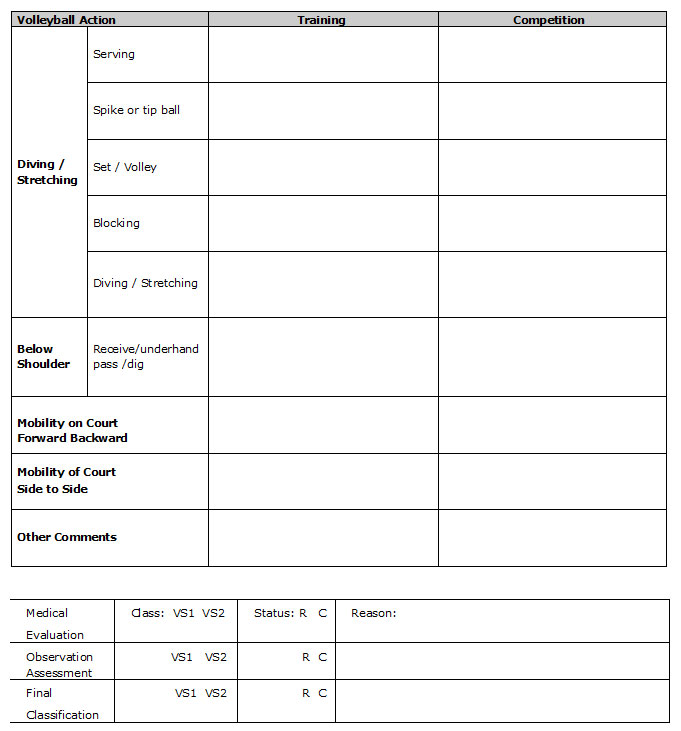 Classifier 1 Name: _______________________Classifier 2 Name: __________________________
REFERENCES
1. Ashworth Scale. www.rehabmeasures.org
2. Clarkson, H. M. Musculoskeletal assessment : joint range of motion and manual muscle strength. 2nd ed. ed. Philadelphia, Lippincott Williams & Wilkins, 2000
3. Hislop, H. J. and J. Montgomery. Daniels and Worthingham's Muscle Testing: Techniques of Manual Examination. 7th ed. Philadelphia: W.B. Saunders Company, 2002
4. Fredericks, C. M. and L. K. Saladin. Pathophysiology of the Motor Systems, 1996
Classifier 1 Name: _______________________Classifier 2 Name: __________________________
REFERENCES
1. Ashworth Scale. www.rehabmeasures.org
2. Clarkson, H. M. Musculoskeletal assessment : joint range of motion and manual muscle strength. 2nd ed. ed. Philadelphia, Lippincott Williams & Wilkins, 2000
3. Hislop, H. J. and J. Montgomery. Daniels and Worthingham's Muscle Testing: Techniques of Manual Examination. 7th ed. Philadelphia: W.B. Saunders Company, 2002
4. Fredericks, C. M. and L. K. Saladin. Pathophysiology of the Motor Systems, 1996


 |
|



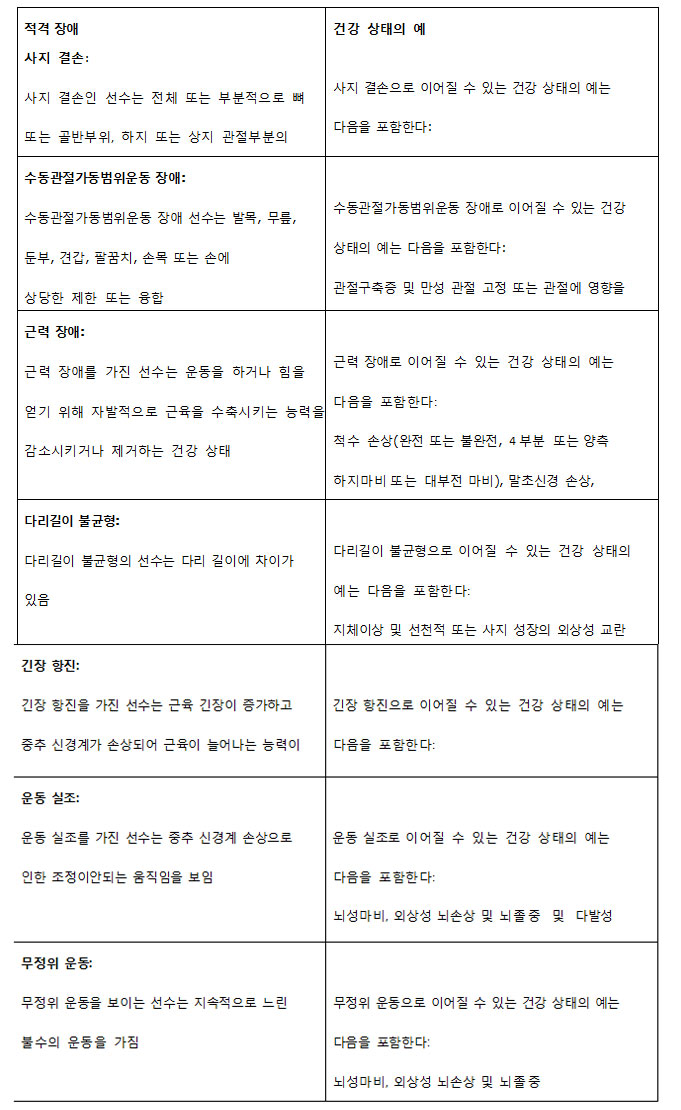 부록 2
1 모든 선수에 적용되는 부적격 장애
부적격 장애의 예는 다음을 포함하지만 이에 국한되지는 않는다:
• 통증;
• 청각 장애;
• 저 근긴장;
• 관절 운동 기능 과잉증;
• 불안정 견갑관절, 재발성 관절탈구 같은 관절 불안정;
• 근지구력 장애;
• 운동반사 기능 장애;
• 심혈관 기능 장애;
• 호흡 기능 장애;
• 신진대사 기능 장애; 그리고
• 틱 및 기행증, 상동증 및 운동이상언행반복증.
2 모든 선수의 근본적인 건강 상태가 아닌 건강 상태
몇몇의 건강 상태는 적격 장애에 연결될 수 없으므로 근본적인 건강상태로 간주되지 않는다(용어 사전
참고).
주로 통증을 유발하는 건강 상태; 주로 피로 유발; 주로 관절 운동기능 과잉증 또는 저혈압의 원인;
또는 주로 심리적, 심신증은 사실상 적격장애에 이를 수 없다.
근막통증 기능장애증후군, 섬유근육통증후군 또는 복합부위통증증후군을 포함한 주로 통증 유발의
원인인 건강 상태의 예들이 있다. 선수는 이런 건강상태를 가지고 있을 수 있으나 이런 건강상태의
존재와는 별개로 적격 장애에 들 수 없다.
주로 피로를 유발하는 건강상태의 예로 만성피로증이 있다.
주로 운동기능 과잉증 또는 저혈압증을 유발하는 건강상태의 예로 엘러스-단로스증후군이 있다.
주로 심리적 또는 심신증의 현실적으로 원인이되는 건강상태의 예로 전환 장애 또는 외상 후
스트레스 장애를 포함한다.
부록 3
좌식 배구
1 최소 장애 기준 (MIC)
1.1 최소 장애 기준은 세계장애인배구 종목 규율에 맞는 자격을 위해 선수의 장애가 얼마나
심각한지를 정의한다.
1.2 세계장애인배구는 부록 3의 좌식(및 좌식 비치)배구에 대한 최소 장애 기준을 가진다:
• 여기서 설명된 장애는 경기가 가능하고 기능에 나쁜 영향을 미칠 수 있는 방식으로
좌식배구와 관련된 핵심 기능의 생체 역학적 실행을 변경하는 것으로 간주된다.
• 좌식배구에서 고려해야 할 기능은 다음과 같다:
o 서브
o 디그
o 오버헤드 패스/세트
o 스파이크
o 블로킹
o 디바이드/스트레치
o 코트에서의 좌식 상태 이동
1.3 좌식배구 스포츠 규율의 최소 장애 기준
1.3.1 사지 결손
사지 결손은 절단(예. 외상이나 골암과 같은 질병으로 인한) 또는 지체이상의 결과일 수 있고 이는
결여 또는 사지 단증에 의해 선천성 기형 정의된다.
아래의 각 기준에는 두 가지 구성 요소가 있다:
• 최소 장애 기준을 충족하는 절단에 관한 서술
• 최소 장애 기준을 충족하는 지체이상에 관한 서술
1.3.1.1 사지 결손 – 하부 사지
부록 2
1 모든 선수에 적용되는 부적격 장애
부적격 장애의 예는 다음을 포함하지만 이에 국한되지는 않는다:
• 통증;
• 청각 장애;
• 저 근긴장;
• 관절 운동 기능 과잉증;
• 불안정 견갑관절, 재발성 관절탈구 같은 관절 불안정;
• 근지구력 장애;
• 운동반사 기능 장애;
• 심혈관 기능 장애;
• 호흡 기능 장애;
• 신진대사 기능 장애; 그리고
• 틱 및 기행증, 상동증 및 운동이상언행반복증.
2 모든 선수의 근본적인 건강 상태가 아닌 건강 상태
몇몇의 건강 상태는 적격 장애에 연결될 수 없으므로 근본적인 건강상태로 간주되지 않는다(용어 사전
참고).
주로 통증을 유발하는 건강 상태; 주로 피로 유발; 주로 관절 운동기능 과잉증 또는 저혈압의 원인;
또는 주로 심리적, 심신증은 사실상 적격장애에 이를 수 없다.
근막통증 기능장애증후군, 섬유근육통증후군 또는 복합부위통증증후군을 포함한 주로 통증 유발의
원인인 건강 상태의 예들이 있다. 선수는 이런 건강상태를 가지고 있을 수 있으나 이런 건강상태의
존재와는 별개로 적격 장애에 들 수 없다.
주로 피로를 유발하는 건강상태의 예로 만성피로증이 있다.
주로 운동기능 과잉증 또는 저혈압증을 유발하는 건강상태의 예로 엘러스-단로스증후군이 있다.
주로 심리적 또는 심신증의 현실적으로 원인이되는 건강상태의 예로 전환 장애 또는 외상 후
스트레스 장애를 포함한다.
부록 3
좌식 배구
1 최소 장애 기준 (MIC)
1.1 최소 장애 기준은 세계장애인배구 종목 규율에 맞는 자격을 위해 선수의 장애가 얼마나
심각한지를 정의한다.
1.2 세계장애인배구는 부록 3의 좌식(및 좌식 비치)배구에 대한 최소 장애 기준을 가진다:
• 여기서 설명된 장애는 경기가 가능하고 기능에 나쁜 영향을 미칠 수 있는 방식으로
좌식배구와 관련된 핵심 기능의 생체 역학적 실행을 변경하는 것으로 간주된다.
• 좌식배구에서 고려해야 할 기능은 다음과 같다:
o 서브
o 디그
o 오버헤드 패스/세트
o 스파이크
o 블로킹
o 디바이드/스트레치
o 코트에서의 좌식 상태 이동
1.3 좌식배구 스포츠 규율의 최소 장애 기준
1.3.1 사지 결손
사지 결손은 절단(예. 외상이나 골암과 같은 질병으로 인한) 또는 지체이상의 결과일 수 있고 이는
결여 또는 사지 단증에 의해 선천성 기형 정의된다.
아래의 각 기준에는 두 가지 구성 요소가 있다:
• 최소 장애 기준을 충족하는 절단에 관한 서술
• 최소 장애 기준을 충족하는 지체이상에 관한 서술
1.3.1.1 사지 결손 – 하부 사지
 1.3.1.2 사지 결손 – 상부 사지
1.3.1.2 사지 결손 – 상부 사지
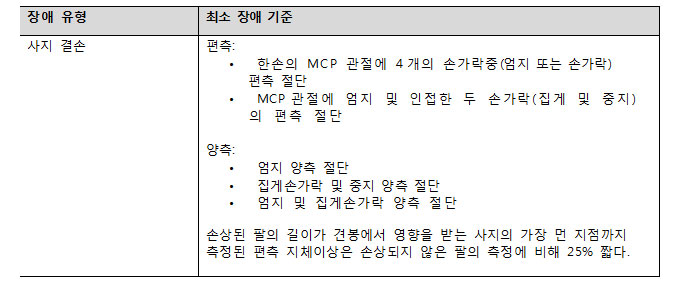 1.3.2 수동관절가동범위운동 장애 (PROM)
달리 명시죄지 않는 한, PROM은 Clarkson(2)이 기술한 계획서를 사용하여 평가해야 한다. 간단히 말해서,
PROM의 측정은 선수가 완전히 휴식을 취해야하며, 등급분류사는 관심부분의 관절을 가능한 범위 내에서
이동시킨다. 선수는 이 테스트 중 편안한 자세를 취하고 자발적인 움직임을 시도해서는 안된다. (참고)
1.3.2.1 수동관절가동범위운동 장애 – 하부 사지
하나의 하부 사지가 다음 기준을 충족시키는 경우, 하부 사지의 수동관절가동범위운동 장애에 대한 최소
장애 기준이 충족된다:
1.3.2 수동관절가동범위운동 장애 (PROM)
달리 명시죄지 않는 한, PROM은 Clarkson(2)이 기술한 계획서를 사용하여 평가해야 한다. 간단히 말해서,
PROM의 측정은 선수가 완전히 휴식을 취해야하며, 등급분류사는 관심부분의 관절을 가능한 범위 내에서
이동시킨다. 선수는 이 테스트 중 편안한 자세를 취하고 자발적인 움직임을 시도해서는 안된다. (참고)
1.3.2.1 수동관절가동범위운동 장애 – 하부 사지
하나의 하부 사지가 다음 기준을 충족시키는 경우, 하부 사지의 수동관절가동범위운동 장애에 대한 최소
장애 기준이 충족된다:
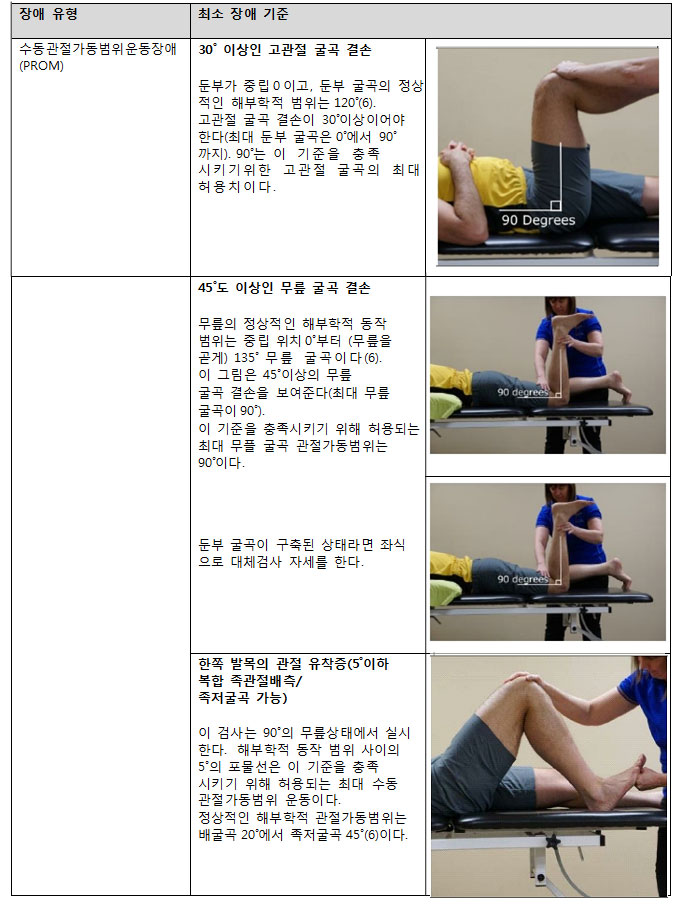 1.3.2.2 수동관절가동범위운동 장애 – 상부 사지
하나의 상부 사지가 다음 기준을 충족시키는 경우, 상부 사지의 수동관절가동범위운동 장애에 대한 최소
장애 기준이 충족된다:
1.3.2.2 수동관절가동범위운동 장애 – 상부 사지
하나의 상부 사지가 다음 기준을 충족시키는 경우, 상부 사지의 수동관절가동범위운동 장애에 대한 최소
장애 기준이 충족된다:
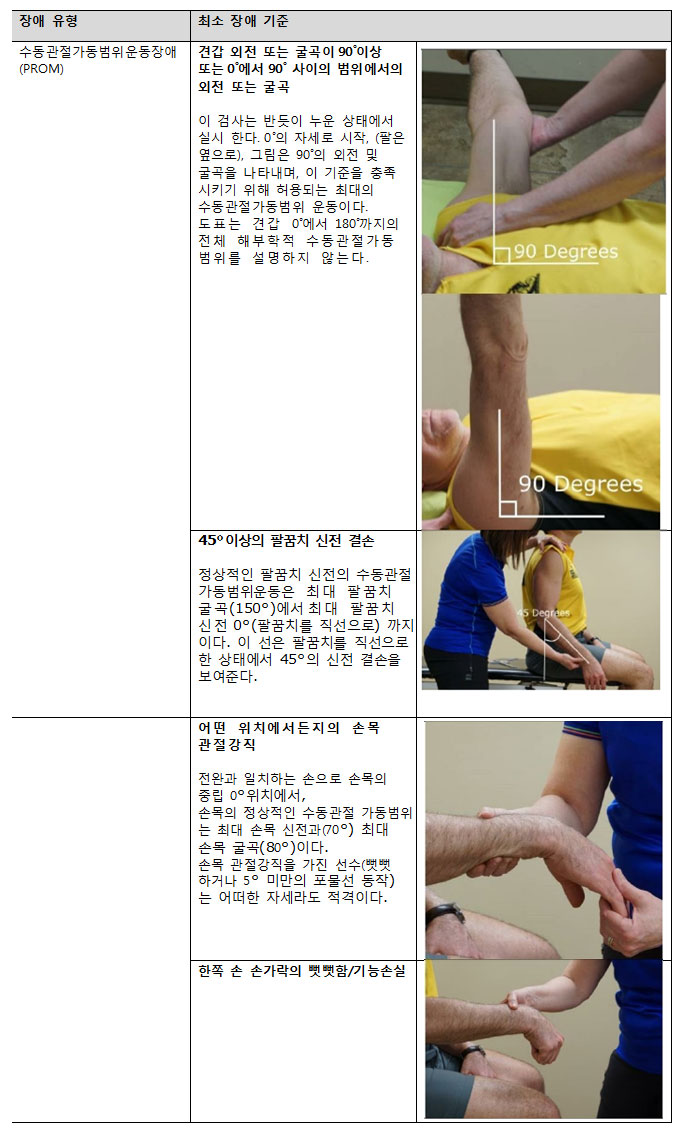 1.3.3 근력 장애
근력은 2007년에 발행된 Daniels and Worthingham (D&W) 규칙에 따라 평가 한다.
평가 방법론에 대한 자세한 내용은 부록 2.2 참조.
1.3.3.1 근력 장애 - 하부 사지
다음 기준을 충족하는 선수는 자격이 있다:
1.3.3 근력 장애
근력은 2007년에 발행된 Daniels and Worthingham (D&W) 규칙에 따라 평가 한다.
평가 방법론에 대한 자세한 내용은 부록 2.2 참조.
1.3.3.1 근력 장애 - 하부 사지
다음 기준을 충족하는 선수는 자격이 있다:
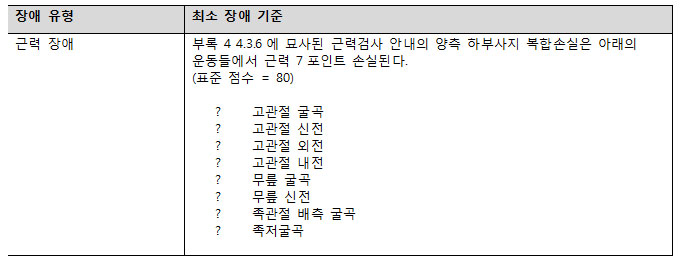 1.3.3.2 근력 장애 – 상부 사지
다음 기준을 충족하는 선수는 자격이 있다:
1.3.3.2 근력 장애 – 상부 사지
다음 기준을 충족하는 선수는 자격이 있다:
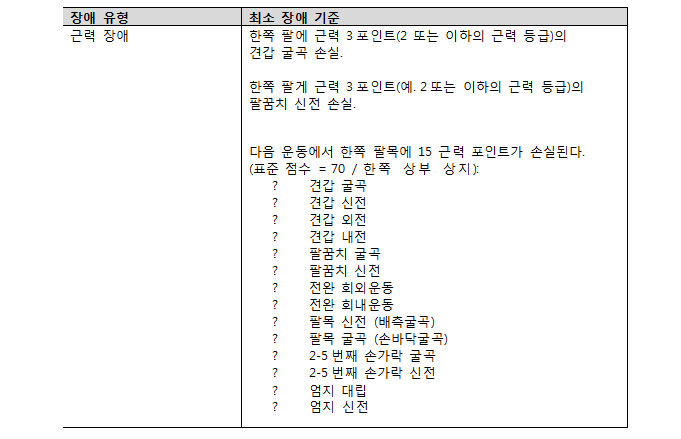 1.3.4 사지 길이 차이
오른쪽과 왼쪽 다리 사이의 길이 차이는 7% 또는 그 이상이어야 하고, 상전장골극부터 가장 아래의 (꼬리쪽) 복사뼈 안쪽 끝지점까지를 측정한다.
1.3.5 긴장 항진
강직 등급은 세계장애인배구 규칙 및 규정의Ashworth 척도 (1)를 참조한다:
• 등급 0: 탄력 증가 없음
• 등급 1: 사지가 신전 또는 굴곡상태에 “잡기”를 할 때 약간의 탄력 증가
• 등급 2: 탄력의 더 현저한 증가, 하지만 사지가 쉽게 굴곡 또는 신전
• 등급 3: 수동적인 움직임을 통한 탄력의 상당한 증가
• 등급 4: 굴곡 또는 신전에 따른 사지 경직
긴장 항진은 중추 신경계 손상에 의해 유발되고 근육의 수동적 신전에 의한 증가된 저항을 초래하는
증가된 근육의 탄력으로 정의된다(4).
다음과 같은 유형의 긴장 항진 중 하나가 임상적으로 검출 가능해야 한다 – (예. 상부 사지의
팔목, 팔꿈치, 또는 견갑이 Ashworth 척도 (1)의 등급 1이거나 발목과 무릎 또는 고관절의
등급 1).
• 강직 긴장항진
• 경직
• 긴장항진
강직, 경직, 또는 근긴장이상의 긴장항진의 세가지 중 하나를 가지고 있지 않은
선수는 부적격이다.
등급분류 패널은 근육의 수동적 신전에 대한 저항이 중추 신경계 장애에 기인하며 다음과 같은 징후가
이와 관련하여 유용할 수 있음을 납득받아야 한다:
• 긴장이 증가하는 쪽에 non-dampingclonus의 존재;
• 긴장이 증가되는 사지의 비정상적 반사 항진;
• 긴장이 증가되는 사지의 경미한 위축;
• 긴장이 증가하는 쪽에 양성 바빈스키.
1.3.6 운동실조
운동실조증은 불안정, 불일치 혹은 의지적 움직임의 서투름을(4) 나타낸다. 적격운동실조는 운동신경
이나 감각신경계 장애로 인해 발생된다. 운동실조는 기형이나 소뇌손상으로 가장 많이 발생하며 종종
긴장 긴장저하(4)와 관련이 있다. 운동실조는 시각적 자극에 의해 불분명한 대상성이 나타난다.
감각적 운동실조는 하위 운동신경손상이나 척수질병, 전정기능이나 고유감각 기능에 영향을 주는 경우가
가장 흔하다. 시각적 자극은 감각적 운동실조를 보충하는데 도움이 되므로 감각적 운동실조는 눈을
감았을 때 더 분명하다(4)
선수평가를 할 때, 등급분류 패널은 등급분류 중에 실조성 움직임은 증명 가능하고 분명하게 나타나며,
관찰된 운동실조는 설명된 것과 같이 운동적 또는 감각적 신경계 기능 장애로 인한 것임을 확인해야
한다:
손가락 코 검사 (선수는 똑바로 선 자세에서 자신의 코 끝을 댄다);
손가락 맞대기 검사 (등급분류사는 자신의 검지손가락을 맞대어 터치하도록 요청한다);
발가락 손가락 맞대기 검사 (등급분류사는 선수의 발가락으로 자신의 검지손가락을
터치하도록 요청한다);
발뒤꿈치-정강이 따라 내려가기 검사 (예. 한쪽 다리의 발뒤꿈치를 반대쪽 정강이를 따라
내려가고 다시 반대로 한다);
• 일자걸음;
• 보행.
1.3.7 무정위운동
무정위운동은 뇌의 운동조절센터의 손상으로 인한 원하지 않는 움직임과 자세를 말한다. 가장 흔하게
기저핵이 있다. 선수평가 때 등급분류 패널은 무정위운동이 분명하고 이것이 근본적으로 신경학적임을
분명히 해야 한다. 명백한 무정위운동은 특징적으로 무정위이고 다음 중 적어도 하나로서 관찰이
가능한 불필요한 움직임과 자세이다:
• 선수가 정지 상태를 유지하려고 노력함에도 불구하고 손가락 또는 상지의 무의식적인
움직임;
• 선수가 정지 상태를 유지하려고 노력함에도 불구하고 발가락 또는 하지의 무의식적인
움직임;
• 몸을 흔들리지 못하게 한다. 흔들리는 것은 전정 또는 고유감각 장애와 같은 다른 신경학적
결손 때문이 아니므로 눈을 감음으로써 악화되어서는 안 된다;
• 팔다리 및/또는 몸통의 특징적인 무정위자세;
얼굴의 무정위움직임이 유일한 장애인 경우 선수는 자격이 없을 것이다.
1.3.5 – 1.3.7관련: 선수는 코트 밖 및 코트에서 핵심적인 배구 기능을 수행하는 동안 운동실조증, 무정위운동 또는 근긴장이상과 같은 경직의 증거(탄력 증가)를 바탕으로한 활동제한을 입증해야 한다.
예. CP-ISRA - 등급 8
“선수는 최소한의 사지마비, 반신불수 및 부분마비로 인한 영향을 받거나 최소한의운동 조절 패턴을
가지고 있다. 그들은 눈에 띄게 절뚝거리지 않게 달릴 것이지만 장애로 인해 노력이 필요할 것이다.
그러나 선수는 검사동안 기능 장애의 증거를 보여주어야 한다. 최소한의 개입이 되는 선수는 정상적
으로 기능되는 것처럼 보일 수 있지만 선수는 경기장에서 경기를 하는 동안(탄력 증가), 운동실조증,
무정위운동 또는 근긴장이상과 같은 경직의 증거를 바탕으로 등급분류사들에게 기능 제한을 입증해야
한다. 뇌 손상이 있는 일부 선수는 우세한 쪽이 장애의 면일 수 있다.
2 평가 방법론
2.1 사지 결손
2.1.1 참고: 인체 측정의 관점에서, 평균적으로 두가지의 조치가 취해진다. 이 두 측정 값의 차이가
1%보다 큰 경우, 하나의 추가 측정 값이 취해지고 중간 값은 측정 값으로 등급분류지에 기록
된다.
2.1.2 상부 사지 결손을 측정할 때, 견봉에서부터 가장 긴 손가락의 끝까지 측정을 한다. (또는 BEA
절단된 끝부분 까지의 길이를 평가하는 경우 요골경상돌기)
2.2 수동관절가동범위운동장애(PROM)
2.2.1 따로 명시되지 않는 한 PROM은 Clarkson(2)이 설명한 프로토콜을 사용하여 평가해야 한다.
간단히 말해 PROM의 측정은 등급분류사가 가동범위 내에 관절을 움직이는 동안 선수는
완전히 휴식을 취해야 한다. 선수는 검사 중 편안한 자세를 취하고 자발적인 움직임을 시도
해서는 안된다. PROM 검사는 각도계를 사용하여 수행해야 한다.
2.3 근력 장애 - 근력 검사
2.3.1 상지 또는 하지를 포함한 근력 장애에 대한 검사를 수행할 때 다음과 같은 동작을 등급분류사가 검사
해야 한다:
1.3.4 사지 길이 차이
오른쪽과 왼쪽 다리 사이의 길이 차이는 7% 또는 그 이상이어야 하고, 상전장골극부터 가장 아래의 (꼬리쪽) 복사뼈 안쪽 끝지점까지를 측정한다.
1.3.5 긴장 항진
강직 등급은 세계장애인배구 규칙 및 규정의Ashworth 척도 (1)를 참조한다:
• 등급 0: 탄력 증가 없음
• 등급 1: 사지가 신전 또는 굴곡상태에 “잡기”를 할 때 약간의 탄력 증가
• 등급 2: 탄력의 더 현저한 증가, 하지만 사지가 쉽게 굴곡 또는 신전
• 등급 3: 수동적인 움직임을 통한 탄력의 상당한 증가
• 등급 4: 굴곡 또는 신전에 따른 사지 경직
긴장 항진은 중추 신경계 손상에 의해 유발되고 근육의 수동적 신전에 의한 증가된 저항을 초래하는
증가된 근육의 탄력으로 정의된다(4).
다음과 같은 유형의 긴장 항진 중 하나가 임상적으로 검출 가능해야 한다 – (예. 상부 사지의
팔목, 팔꿈치, 또는 견갑이 Ashworth 척도 (1)의 등급 1이거나 발목과 무릎 또는 고관절의
등급 1).
• 강직 긴장항진
• 경직
• 긴장항진
강직, 경직, 또는 근긴장이상의 긴장항진의 세가지 중 하나를 가지고 있지 않은
선수는 부적격이다.
등급분류 패널은 근육의 수동적 신전에 대한 저항이 중추 신경계 장애에 기인하며 다음과 같은 징후가
이와 관련하여 유용할 수 있음을 납득받아야 한다:
• 긴장이 증가하는 쪽에 non-dampingclonus의 존재;
• 긴장이 증가되는 사지의 비정상적 반사 항진;
• 긴장이 증가되는 사지의 경미한 위축;
• 긴장이 증가하는 쪽에 양성 바빈스키.
1.3.6 운동실조
운동실조증은 불안정, 불일치 혹은 의지적 움직임의 서투름을(4) 나타낸다. 적격운동실조는 운동신경
이나 감각신경계 장애로 인해 발생된다. 운동실조는 기형이나 소뇌손상으로 가장 많이 발생하며 종종
긴장 긴장저하(4)와 관련이 있다. 운동실조는 시각적 자극에 의해 불분명한 대상성이 나타난다.
감각적 운동실조는 하위 운동신경손상이나 척수질병, 전정기능이나 고유감각 기능에 영향을 주는 경우가
가장 흔하다. 시각적 자극은 감각적 운동실조를 보충하는데 도움이 되므로 감각적 운동실조는 눈을
감았을 때 더 분명하다(4)
선수평가를 할 때, 등급분류 패널은 등급분류 중에 실조성 움직임은 증명 가능하고 분명하게 나타나며,
관찰된 운동실조는 설명된 것과 같이 운동적 또는 감각적 신경계 기능 장애로 인한 것임을 확인해야
한다:
손가락 코 검사 (선수는 똑바로 선 자세에서 자신의 코 끝을 댄다);
손가락 맞대기 검사 (등급분류사는 자신의 검지손가락을 맞대어 터치하도록 요청한다);
발가락 손가락 맞대기 검사 (등급분류사는 선수의 발가락으로 자신의 검지손가락을
터치하도록 요청한다);
발뒤꿈치-정강이 따라 내려가기 검사 (예. 한쪽 다리의 발뒤꿈치를 반대쪽 정강이를 따라
내려가고 다시 반대로 한다);
• 일자걸음;
• 보행.
1.3.7 무정위운동
무정위운동은 뇌의 운동조절센터의 손상으로 인한 원하지 않는 움직임과 자세를 말한다. 가장 흔하게
기저핵이 있다. 선수평가 때 등급분류 패널은 무정위운동이 분명하고 이것이 근본적으로 신경학적임을
분명히 해야 한다. 명백한 무정위운동은 특징적으로 무정위이고 다음 중 적어도 하나로서 관찰이
가능한 불필요한 움직임과 자세이다:
• 선수가 정지 상태를 유지하려고 노력함에도 불구하고 손가락 또는 상지의 무의식적인
움직임;
• 선수가 정지 상태를 유지하려고 노력함에도 불구하고 발가락 또는 하지의 무의식적인
움직임;
• 몸을 흔들리지 못하게 한다. 흔들리는 것은 전정 또는 고유감각 장애와 같은 다른 신경학적
결손 때문이 아니므로 눈을 감음으로써 악화되어서는 안 된다;
• 팔다리 및/또는 몸통의 특징적인 무정위자세;
얼굴의 무정위움직임이 유일한 장애인 경우 선수는 자격이 없을 것이다.
1.3.5 – 1.3.7관련: 선수는 코트 밖 및 코트에서 핵심적인 배구 기능을 수행하는 동안 운동실조증, 무정위운동 또는 근긴장이상과 같은 경직의 증거(탄력 증가)를 바탕으로한 활동제한을 입증해야 한다.
예. CP-ISRA - 등급 8
“선수는 최소한의 사지마비, 반신불수 및 부분마비로 인한 영향을 받거나 최소한의운동 조절 패턴을
가지고 있다. 그들은 눈에 띄게 절뚝거리지 않게 달릴 것이지만 장애로 인해 노력이 필요할 것이다.
그러나 선수는 검사동안 기능 장애의 증거를 보여주어야 한다. 최소한의 개입이 되는 선수는 정상적
으로 기능되는 것처럼 보일 수 있지만 선수는 경기장에서 경기를 하는 동안(탄력 증가), 운동실조증,
무정위운동 또는 근긴장이상과 같은 경직의 증거를 바탕으로 등급분류사들에게 기능 제한을 입증해야
한다. 뇌 손상이 있는 일부 선수는 우세한 쪽이 장애의 면일 수 있다.
2 평가 방법론
2.1 사지 결손
2.1.1 참고: 인체 측정의 관점에서, 평균적으로 두가지의 조치가 취해진다. 이 두 측정 값의 차이가
1%보다 큰 경우, 하나의 추가 측정 값이 취해지고 중간 값은 측정 값으로 등급분류지에 기록
된다.
2.1.2 상부 사지 결손을 측정할 때, 견봉에서부터 가장 긴 손가락의 끝까지 측정을 한다. (또는 BEA
절단된 끝부분 까지의 길이를 평가하는 경우 요골경상돌기)
2.2 수동관절가동범위운동장애(PROM)
2.2.1 따로 명시되지 않는 한 PROM은 Clarkson(2)이 설명한 프로토콜을 사용하여 평가해야 한다.
간단히 말해 PROM의 측정은 등급분류사가 가동범위 내에 관절을 움직이는 동안 선수는
완전히 휴식을 취해야 한다. 선수는 검사 중 편안한 자세를 취하고 자발적인 움직임을 시도
해서는 안된다. PROM 검사는 각도계를 사용하여 수행해야 한다.
2.3 근력 장애 - 근력 검사
2.3.1 상지 또는 하지를 포함한 근력 장애에 대한 검사를 수행할 때 다음과 같은 동작을 등급분류사가 검사
해야 한다:
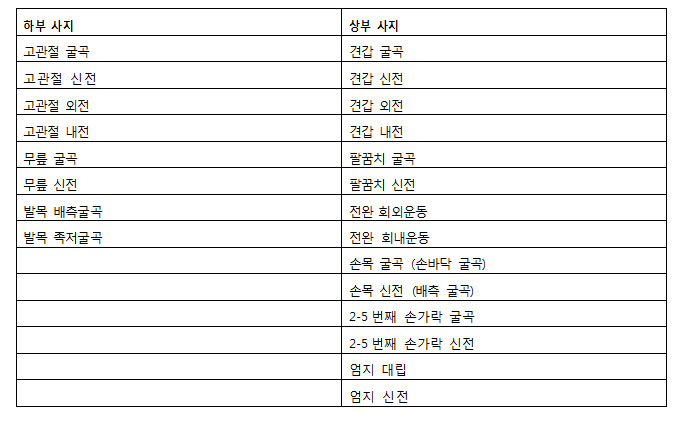 2.3.2: 근력은 2007년에 출판된 Daniels and Worthingham(D&W)(3) 척도에 따라 평가될 것이다. 척도는
6개의 레벨이 있으며 0-5이다:
• 5: 가능한 관절가동범위운동을 통한 정상적인 근력
• 4: 가능한 관절가동범위운동을 통한 능동운동, 약간의 저항력이 더해진 중력에 반함
• 3: 최대 가능한 관절가동범위운동을 통한 능동운동, 중력에 반하지만 저항력이 없음
• 2: 중력이 빠진 능동운동 (중력에 반하는 운동이 가능할 수 있으나, 전체 범위는 아님);
• 1: 근육 움직임이 미량으로 보일 수 있으나, 사지는 움직이지 않음
• 0: 근육 활동 없음
이 측정은 하나의 수정을 위해 이용될 것이다: Daniel과 Worthingham척도의 점수 0,1과 2는 모두 0점으로 기록된다. 또한 족저굴곡 강화 검사가 수정되었다.
2.3.3 위의 근력 등급은 주어진 저항량을 가진 최대(능동/수동) 관절가동범위운동에 대해 등급이 주어
지는 반면, 관절가동범위운동의(능동 또는 수동)의 손실은 힘과 기능을 발휘하는 근육의 능력에 영향을
미친다. 아래의 지침은 검사를 통해 근육 등급을 조정할 때 고려되어야 한다:
• ¾ - 최대관절가동범위운동 - 근육 등급 주어짐
• ½ - ¾ 관절가동범위운동 - 근육 등급 1점 감점
• ¼ - ½ 관절가동범위운동 - 근육 등급 2점 감점
• 0 - ¼ 관절가동범위운동 - 근육 등급 3점 감점
2.3.4 통증은 등급분류의 등급을 매길 때 고려될 수 없다. 통증으로 인해 검사가 방해된다면 근육의
강도는 5/5로 매겨야 한다.
2.3.5 선수가 1차 검사 자세로 검사를 받을 수 없는 경우를 제외하고는 1차 검사 자세로 측정해야 한다. 이럴 경우, 대체 자세를 할 수 있다.
2.3.6
2.3.2: 근력은 2007년에 출판된 Daniels and Worthingham(D&W)(3) 척도에 따라 평가될 것이다. 척도는
6개의 레벨이 있으며 0-5이다:
• 5: 가능한 관절가동범위운동을 통한 정상적인 근력
• 4: 가능한 관절가동범위운동을 통한 능동운동, 약간의 저항력이 더해진 중력에 반함
• 3: 최대 가능한 관절가동범위운동을 통한 능동운동, 중력에 반하지만 저항력이 없음
• 2: 중력이 빠진 능동운동 (중력에 반하는 운동이 가능할 수 있으나, 전체 범위는 아님);
• 1: 근육 움직임이 미량으로 보일 수 있으나, 사지는 움직이지 않음
• 0: 근육 활동 없음
이 측정은 하나의 수정을 위해 이용될 것이다: Daniel과 Worthingham척도의 점수 0,1과 2는 모두 0점으로 기록된다. 또한 족저굴곡 강화 검사가 수정되었다.
2.3.3 위의 근력 등급은 주어진 저항량을 가진 최대(능동/수동) 관절가동범위운동에 대해 등급이 주어
지는 반면, 관절가동범위운동의(능동 또는 수동)의 손실은 힘과 기능을 발휘하는 근육의 능력에 영향을
미친다. 아래의 지침은 검사를 통해 근육 등급을 조정할 때 고려되어야 한다:
• ¾ - 최대관절가동범위운동 - 근육 등급 주어짐
• ½ - ¾ 관절가동범위운동 - 근육 등급 1점 감점
• ¼ - ½ 관절가동범위운동 - 근육 등급 2점 감점
• 0 - ¼ 관절가동범위운동 - 근육 등급 3점 감점
2.3.4 통증은 등급분류의 등급을 매길 때 고려될 수 없다. 통증으로 인해 검사가 방해된다면 근육의
강도는 5/5로 매겨야 한다.
2.3.5 선수가 1차 검사 자세로 검사를 받을 수 없는 경우를 제외하고는 1차 검사 자세로 측정해야 한다. 이럴 경우, 대체 자세를 할 수 있다.
2.3.6
 2.4 다리 길이 불균형
2.4.1 측정을 위해 선수는 다리를 편안하게 모두 쭉 펴고 누워야 한다.ㅏ 상전장골극의 아래 측면
부터 각각 다리의 내과(안쪽)끝까지 측정한 후 비교한다.
2.4.2 다리 길이의 불균형은 백분율로 표시된다.:
(짧은 사지/영향을 받지 않은 사지) x 100
주의: 인체측정학 관점에서 평균 2번 측정이 진행된다. 이 2번의 측정간 차이가 1% 보다 클 경우
추가로 1번 더 측정하고 중간 측정이 등급분류문서에 측정값으로 기록된다.
2.5 근육긴장항진
세계장애인배구 규칙 및 규정에 따라 등급은 Ashworth 척도 (1)를 나타낸다:
• 등급 0: 근윤긴장 증가없음
등급 1: 사지가 굴곡 또는 신전일 때 약간의 근육긴장이 증가
• 등급 2: 근육긴장이 증가하는 것이 현저히 나타남. 하지만 팔다리는 쉽게 굴곡 또는 신전됨
• 등급 3: 수동적인 움직임을 통한 근육긴장의 상당한 증가
• 등급 4: 사지를 굴곡 또는 신전하는데 경직됨
근육긴장항진은 중추신경계 손상에 의해 발생되며 근육의 수동적 연장(4)에 대한 저항력을 증가시키는
증가된 근육간장으로 정의된다.
다음과 같은 유형의 근육긴장항진 중 하나가 명확하게 임상적으로 감지되어야 한다. 예를 들어, 손목,
팔꿈치, 어깨, 발목, 무릎 또는 엉덩이에서 애쉬워드 척도(Ashworth scale)(1) 의 등급 1.
2.5.1 경직 근육긴장항진증: 재크나이프형저항(4)(clasp-knife type of resistance)의 수동적 움직임에
대한 속도- 의존성 저항으로 정의된다. 재크나이프형저항은 초기에 높고 갑작스런 이완으로 인한 저항
이다. 속도 의존성은 수동적 움직임의 속도가 증가함에 따라 증가하고 저항은 더 커져서 범위 내에서
더 일찍 시작된다.
경직 근육긴장항진은 항중력근 특히 팔의 굴전 및 다리의 신전에서 우세한 경향이 있으며 다른 부위
보다 신체의 특정 부위에 더 영향을 미칠 수 있다. 등급분류에서 경직 근육긴장항진 검사는 손목,
팔꿈치, 어깨, 발목, 무릎, 또는 엉덩이의 주요 운동 범위를 통해 신속하고 수동적인 움직임을 포함한다. 명확하게 임상적으로 감지할 수 있는 경련성 근육긴장항진이 있는 선수는 자격이 있다.
발목 또는 손목의 경직 근육긴장항진 검사를 할 때 클로누스(Clonus)는 유발된다. 클로누스는 빠르고 근육수축과 이완의 무의식적인 전환이며 전형적으로 빠르게 반응하는 발목족저굴곡, 수동적인 배측굴곡, 빠르고 수동적 손목확장에 대해 반응 하는 손목굴곡에서 발생한다
4박자 또는 이상 지속되고 단일 등급분류기간 동안 (예, non-damping clonus) 클노누스는 MIC를 충족
하는 경련성 근육긴장항진의 존재를 나타낸다.
2.5.2 경직: 사지(4)의 운동범위 전체를 통해서 상대적으로 균일하고 근육 신장(늘림)속도에 독립적인 사지(팔다리)의 수동적 움직임에 대한 저항이 더 커진 것으로 정의된다. 균등저항은 “연관”유형의 저항이라고도 한다. 일반적으로 더 흔한 굴곡패턴과 함께 주 패턴(predominant pattern) 이 있다.
2.5.3 근긴장이상: 국소(한쪽의 팔다리 또는 관절의 근육에 영향을 미침) 또는 일반 (몸 전체에 영향을
미침)적인 수동적 움직임에 대한 저항이다. 수축은 강하고 지속되며 영향 받은 부분*의 비틀림을 유발
한다. 이 패턴은 매우 다양하다- 수축은 빠르거나 느릴 수 있다: 통증이 있거나 혹은 없을 수 있다: 가장
큰 저항의 방향은 규칙적으로 변할 수 있다(예를 들면, 사지는 극단적인 굴곡패턴에서 신전패턴으로 규칙적으로 움직일 수 있다)(4,10)
*설명에서 알 수 있듯이, 근긴장이상은 동등하게 긴장항진 또는 비자발적 운동 패턴 유형으로 분류될
수 있다.
긴장항진- 경직, 강직 또는 근긴장이상증 의 세 가지 유형 중 하나를 가지고 있지 않는 선수는 자격이
없다.
등급분류패널은 근육의 수동적 신전(늘림)에 대한 저항이 중추신경계 손상에 인한 것임을 인정해야 하며 다음과 같은 증상이 이 점에 유용할 수 있다.
• 긴장이 증가하는 쪽에 non-damping clonus의 존재;
• 긴장이 증가되는 사지(팔다리)의 비정상적 반사항진;
• 긴장이 증가되는 사지(팔다리)의 경미한 위축;
• P긴장이 증가하는 쪽에 양성 바빈스키(Babinski).
2.6 운동실조
운동실조증은 불안정, 불일치 혹은 의지적 움직임의 서투름을(4) 나타낸다. 적격운동실조는 운동신경이나 감각신경계 장애로 인해 발생된다. 운동실조는 기형이나 소뇌손상으로 가장 많이 발생하며 종종 긴장저하(4)와 관련이 있다. 운동실조는 시각적 자극에 의해 불분명한 대상성이 나타난다. 감각적 운동
실조는 하위운동신경손상이나 척수질병, 전정기능이나 고유감각 기능에 영향을 주는 경우가 가장 흔하다. 시각적 자극은 감각적 운동실조를 보충하는데 도움이 되므로 감각적 운동실조는 눈을 감았을 때 더 분명하다(4).
선수평가를 할 때, 등급분류패널은 등급분류 중에 실조성움직임은 증명 가능하고 분명하게 나타나며,
관찰 된 운동실조는 설명 된 것과 같이 운동적 또는 감각적 신경계 기능 장애로 인한 것임을 확인해야
한다:•
손가락코검사(선수는 똑바로 선 자세에서 자신의 코 끝을 댄다);
손가락맞대기검사(등급분류사는 선수가 자신의 검지손가락 터치하도록 요청한다);
발가락손가락맞대기검사(등급분류사는 선수의 발가락으로 자신의 검지손가락을 터치하도록
요청한다);
발뒤꿈치-정강이 따라내겨가기 검사(한쪽 다리의 발뒤꿈치를 반대쪽 정강이를 따라 내려가고
다시 반대로 한다) ;
• 일자 걸음;
• 보행.
2.7 무정위운동
무정위운동(Athetosis)은 뇌의 운동조절센터의 손상으로 인한 원하지 않는 움직임과 자세를 말한다. 가장 흔하게 기저핵이 있다. 선수평가 때 등급분류패널은 무정위운동이 분명하고 이것이 근본적으로 신경학적
임을 분명히 해야 한다. 명백한 무정위운동은 특징적으로 무정위이고 다음 중 적어도 하나로서 관찰이 가능한 불필요한 움직임과 자세이다:
선수가 정지 상태를 유지하려고 노력함에도 불구하고 손가락 또는 상지의 무의식적인 움직임
선수가 정지 상태를 유지하려고 노력함에도 불구하고 발가락 또는 하지의 무의식적인 움직임;
몸을 흔들리지 못하게 한다. 흔들리는 것은 전정 또는 고유감각 장애와 같은 다른 신경학적 결손 때문이 아니므로 눈을 감음으로써 악화되어서는 안 된다;
• 팔다리 및/또는 몸통의 특징적인 무정위자세;
얼굴의 무정위움직임이 유일한 장애인 경우 선수는 자격이 없을 것이다.
3 스포츠등급 할당 및 스포츠등급 상태 지정의 평가 기준
3.1 좌식 배구의 스포츠 규율에는 두개의 등급, VS1 및 VS2 가 있다.
3.1.1 스포츠 등급 VS1 선수
이 선수들은 좌식배구의 핵심기능에 더 영향을 받는 장애를 가지고 있다.
2.4 다리 길이 불균형
2.4.1 측정을 위해 선수는 다리를 편안하게 모두 쭉 펴고 누워야 한다.ㅏ 상전장골극의 아래 측면
부터 각각 다리의 내과(안쪽)끝까지 측정한 후 비교한다.
2.4.2 다리 길이의 불균형은 백분율로 표시된다.:
(짧은 사지/영향을 받지 않은 사지) x 100
주의: 인체측정학 관점에서 평균 2번 측정이 진행된다. 이 2번의 측정간 차이가 1% 보다 클 경우
추가로 1번 더 측정하고 중간 측정이 등급분류문서에 측정값으로 기록된다.
2.5 근육긴장항진
세계장애인배구 규칙 및 규정에 따라 등급은 Ashworth 척도 (1)를 나타낸다:
• 등급 0: 근윤긴장 증가없음
등급 1: 사지가 굴곡 또는 신전일 때 약간의 근육긴장이 증가
• 등급 2: 근육긴장이 증가하는 것이 현저히 나타남. 하지만 팔다리는 쉽게 굴곡 또는 신전됨
• 등급 3: 수동적인 움직임을 통한 근육긴장의 상당한 증가
• 등급 4: 사지를 굴곡 또는 신전하는데 경직됨
근육긴장항진은 중추신경계 손상에 의해 발생되며 근육의 수동적 연장(4)에 대한 저항력을 증가시키는
증가된 근육간장으로 정의된다.
다음과 같은 유형의 근육긴장항진 중 하나가 명확하게 임상적으로 감지되어야 한다. 예를 들어, 손목,
팔꿈치, 어깨, 발목, 무릎 또는 엉덩이에서 애쉬워드 척도(Ashworth scale)(1) 의 등급 1.
2.5.1 경직 근육긴장항진증: 재크나이프형저항(4)(clasp-knife type of resistance)의 수동적 움직임에
대한 속도- 의존성 저항으로 정의된다. 재크나이프형저항은 초기에 높고 갑작스런 이완으로 인한 저항
이다. 속도 의존성은 수동적 움직임의 속도가 증가함에 따라 증가하고 저항은 더 커져서 범위 내에서
더 일찍 시작된다.
경직 근육긴장항진은 항중력근 특히 팔의 굴전 및 다리의 신전에서 우세한 경향이 있으며 다른 부위
보다 신체의 특정 부위에 더 영향을 미칠 수 있다. 등급분류에서 경직 근육긴장항진 검사는 손목,
팔꿈치, 어깨, 발목, 무릎, 또는 엉덩이의 주요 운동 범위를 통해 신속하고 수동적인 움직임을 포함한다. 명확하게 임상적으로 감지할 수 있는 경련성 근육긴장항진이 있는 선수는 자격이 있다.
발목 또는 손목의 경직 근육긴장항진 검사를 할 때 클로누스(Clonus)는 유발된다. 클로누스는 빠르고 근육수축과 이완의 무의식적인 전환이며 전형적으로 빠르게 반응하는 발목족저굴곡, 수동적인 배측굴곡, 빠르고 수동적 손목확장에 대해 반응 하는 손목굴곡에서 발생한다
4박자 또는 이상 지속되고 단일 등급분류기간 동안 (예, non-damping clonus) 클노누스는 MIC를 충족
하는 경련성 근육긴장항진의 존재를 나타낸다.
2.5.2 경직: 사지(4)의 운동범위 전체를 통해서 상대적으로 균일하고 근육 신장(늘림)속도에 독립적인 사지(팔다리)의 수동적 움직임에 대한 저항이 더 커진 것으로 정의된다. 균등저항은 “연관”유형의 저항이라고도 한다. 일반적으로 더 흔한 굴곡패턴과 함께 주 패턴(predominant pattern) 이 있다.
2.5.3 근긴장이상: 국소(한쪽의 팔다리 또는 관절의 근육에 영향을 미침) 또는 일반 (몸 전체에 영향을
미침)적인 수동적 움직임에 대한 저항이다. 수축은 강하고 지속되며 영향 받은 부분*의 비틀림을 유발
한다. 이 패턴은 매우 다양하다- 수축은 빠르거나 느릴 수 있다: 통증이 있거나 혹은 없을 수 있다: 가장
큰 저항의 방향은 규칙적으로 변할 수 있다(예를 들면, 사지는 극단적인 굴곡패턴에서 신전패턴으로 규칙적으로 움직일 수 있다)(4,10)
*설명에서 알 수 있듯이, 근긴장이상은 동등하게 긴장항진 또는 비자발적 운동 패턴 유형으로 분류될
수 있다.
긴장항진- 경직, 강직 또는 근긴장이상증 의 세 가지 유형 중 하나를 가지고 있지 않는 선수는 자격이
없다.
등급분류패널은 근육의 수동적 신전(늘림)에 대한 저항이 중추신경계 손상에 인한 것임을 인정해야 하며 다음과 같은 증상이 이 점에 유용할 수 있다.
• 긴장이 증가하는 쪽에 non-damping clonus의 존재;
• 긴장이 증가되는 사지(팔다리)의 비정상적 반사항진;
• 긴장이 증가되는 사지(팔다리)의 경미한 위축;
• P긴장이 증가하는 쪽에 양성 바빈스키(Babinski).
2.6 운동실조
운동실조증은 불안정, 불일치 혹은 의지적 움직임의 서투름을(4) 나타낸다. 적격운동실조는 운동신경이나 감각신경계 장애로 인해 발생된다. 운동실조는 기형이나 소뇌손상으로 가장 많이 발생하며 종종 긴장저하(4)와 관련이 있다. 운동실조는 시각적 자극에 의해 불분명한 대상성이 나타난다. 감각적 운동
실조는 하위운동신경손상이나 척수질병, 전정기능이나 고유감각 기능에 영향을 주는 경우가 가장 흔하다. 시각적 자극은 감각적 운동실조를 보충하는데 도움이 되므로 감각적 운동실조는 눈을 감았을 때 더 분명하다(4).
선수평가를 할 때, 등급분류패널은 등급분류 중에 실조성움직임은 증명 가능하고 분명하게 나타나며,
관찰 된 운동실조는 설명 된 것과 같이 운동적 또는 감각적 신경계 기능 장애로 인한 것임을 확인해야
한다:•
손가락코검사(선수는 똑바로 선 자세에서 자신의 코 끝을 댄다);
손가락맞대기검사(등급분류사는 선수가 자신의 검지손가락 터치하도록 요청한다);
발가락손가락맞대기검사(등급분류사는 선수의 발가락으로 자신의 검지손가락을 터치하도록
요청한다);
발뒤꿈치-정강이 따라내겨가기 검사(한쪽 다리의 발뒤꿈치를 반대쪽 정강이를 따라 내려가고
다시 반대로 한다) ;
• 일자 걸음;
• 보행.
2.7 무정위운동
무정위운동(Athetosis)은 뇌의 운동조절센터의 손상으로 인한 원하지 않는 움직임과 자세를 말한다. 가장 흔하게 기저핵이 있다. 선수평가 때 등급분류패널은 무정위운동이 분명하고 이것이 근본적으로 신경학적
임을 분명히 해야 한다. 명백한 무정위운동은 특징적으로 무정위이고 다음 중 적어도 하나로서 관찰이 가능한 불필요한 움직임과 자세이다:
선수가 정지 상태를 유지하려고 노력함에도 불구하고 손가락 또는 상지의 무의식적인 움직임
선수가 정지 상태를 유지하려고 노력함에도 불구하고 발가락 또는 하지의 무의식적인 움직임;
몸을 흔들리지 못하게 한다. 흔들리는 것은 전정 또는 고유감각 장애와 같은 다른 신경학적 결손 때문이 아니므로 눈을 감음으로써 악화되어서는 안 된다;
• 팔다리 및/또는 몸통의 특징적인 무정위자세;
얼굴의 무정위움직임이 유일한 장애인 경우 선수는 자격이 없을 것이다.
3 스포츠등급 할당 및 스포츠등급 상태 지정의 평가 기준
3.1 좌식 배구의 스포츠 규율에는 두개의 등급, VS1 및 VS2 가 있다.
3.1.1 스포츠 등급 VS1 선수
이 선수들은 좌식배구의 핵심기능에 더 영향을 받는 장애를 가지고 있다.
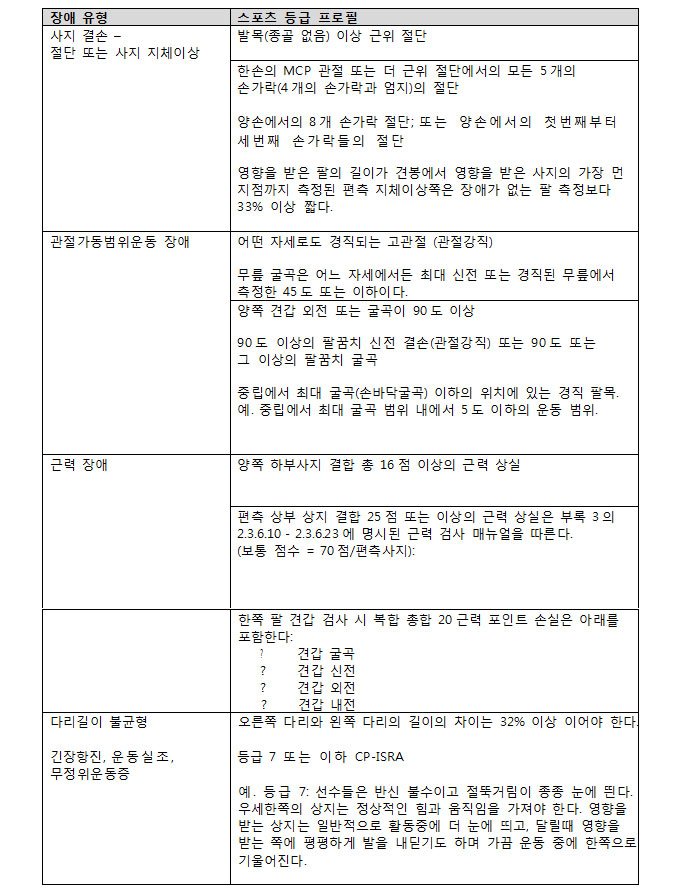 3.1.2 스포츠 등급 VS2 선수
이 선수들은 좌식배구의 핵심기능에 최소 영향을 받는 장애를 가지고 있다.
3.1.2 스포츠 등급 VS2 선수
이 선수들은 좌식배구의 핵심기능에 최소 영향을 받는 장애를 가지고 있다.
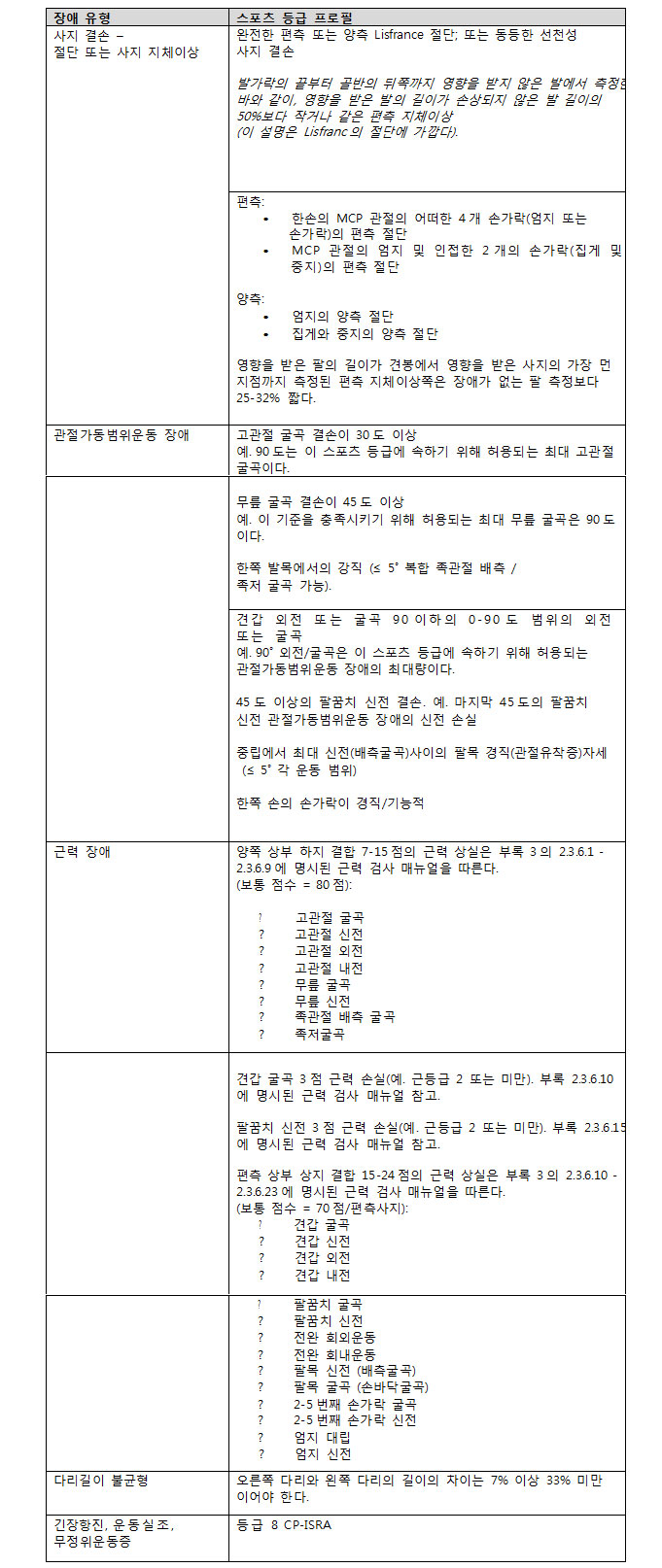 부록 4
1 대회 중 관찰 평가
절단 또는 사지 단축 장애가 있는 적격 선수는 대회 중 관찰 평가를 할 필요가 없다.
절단 또는 사지 단축 장애가 있는 적격 선수를 제외한 등급간의 경계선에 있는 선수들은 대회 중 관찰 평가를 받아야
한다. 코트에서 관찰평가를 받은 선수가 근력, 수동운동 범위, 조정, 경련의 징후, 무정위운동 및 운동실조증 등 코트에서 시연이 가능한 것들 벤치 테스트에서 입증해야 한다.
객관적인 임상 징후와 측정은 다음을 포함하여 좌식배구 기술 전반에 걸쳐 관찰된다:
o 서브
o 디그
o 오버헤드 패스/세트
o 스파이크
o 블로킹
o 디바이드/스트레치
o 코트에서의 좌식 상태 이동
2 관찰 평가 양식
Player Name: ______________________ Team: _____________________ Shirt No: ______
Tournament: _________________________________________________ Date: _________
부록 4
1 대회 중 관찰 평가
절단 또는 사지 단축 장애가 있는 적격 선수는 대회 중 관찰 평가를 할 필요가 없다.
절단 또는 사지 단축 장애가 있는 적격 선수를 제외한 등급간의 경계선에 있는 선수들은 대회 중 관찰 평가를 받아야
한다. 코트에서 관찰평가를 받은 선수가 근력, 수동운동 범위, 조정, 경련의 징후, 무정위운동 및 운동실조증 등 코트에서 시연이 가능한 것들 벤치 테스트에서 입증해야 한다.
객관적인 임상 징후와 측정은 다음을 포함하여 좌식배구 기술 전반에 걸쳐 관찰된다:
o 서브
o 디그
o 오버헤드 패스/세트
o 스파이크
o 블로킹
o 디바이드/스트레치
o 코트에서의 좌식 상태 이동
2 관찰 평가 양식
Player Name: ______________________ Team: _____________________ Shirt No: ______
Tournament: _________________________________________________ Date: _________
 Classifier 1 Name: _______________________Classifier 2 Name: __________________________
참조
1. Ashworth Scale. www.rehabmeasures.org
2. Clarkson, H. M. Musculoskeletal assessment : joint range of motion and manual muscle
strength. 2nd ed. ed. Philadelphia, Lippincott Williams & Wilkins, 2000
3. Hislop, H. J. and J. Montgomery. Daniels and Worthingham's Muscle Testing:
Techniques of Manual Examination. 7th ed. Philadelphia: W.B. Saunders
Company, 2002
4. Fredericks, C. M. and L. K. Saladin. Pathophysiology of the Motor Systems, 1996
Classifier 1 Name: _______________________Classifier 2 Name: __________________________
참조
1. Ashworth Scale. www.rehabmeasures.org
2. Clarkson, H. M. Musculoskeletal assessment : joint range of motion and manual muscle
strength. 2nd ed. ed. Philadelphia, Lippincott Williams & Wilkins, 2000
3. Hislop, H. J. and J. Montgomery. Daniels and Worthingham's Muscle Testing:
Techniques of Manual Examination. 7th ed. Philadelphia: W.B. Saunders
Company, 2002
4. Fredericks, C. M. and L. K. Saladin. Pathophysiology of the Motor Systems, 1996

